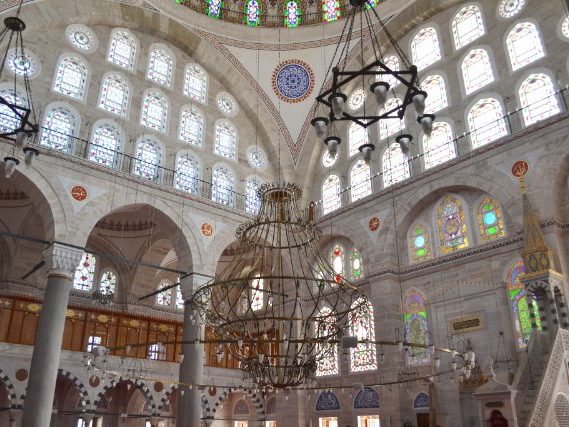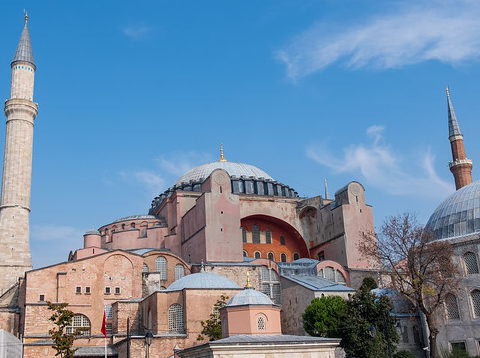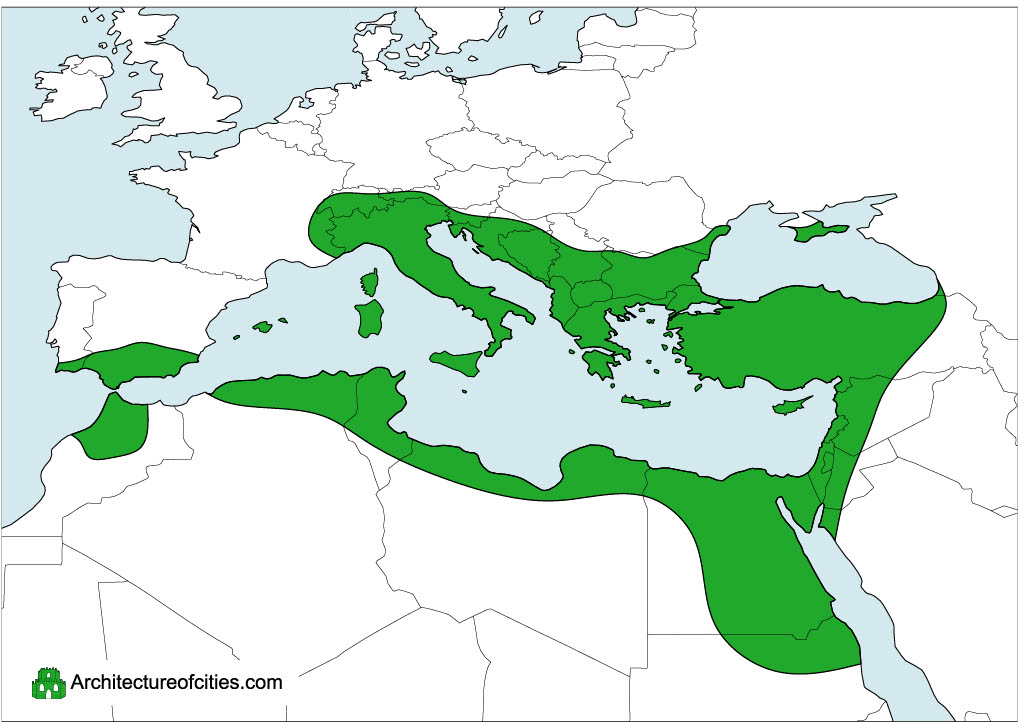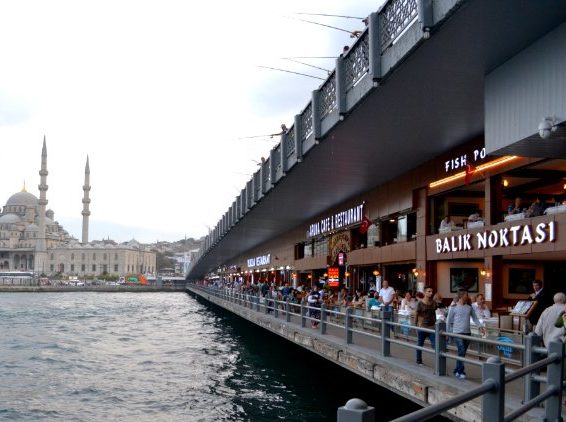Architecture of Istanbul, Turkey
Istanbul is a city connecting east and west, situated at the crossroads of continental Europe and Anatolia in western Asia. Formerly known as Constantinople, the city was established on the strategic Bosphorus Strait – a narrow body of water that is the only passage between the Black Sea and the waters of the Mediterranean. The Eastern Roman and Ottoman Empires both named Constantinople their capital, and both nations built incredible buildings throughout the city. Today Istanbul is the 15th largest city on earth by population, and each year millions of people visit to see its incredible monuments. and to absorb some authentic Turkish culture. The article below will highlight the greatest examples of architecture within Istanbul, breaking them down into three phases: Eastern Roman or Byzantine Architecture in Istanbul > Ottoman Architecture in Istanbul > Modern Architecture in Istanbul
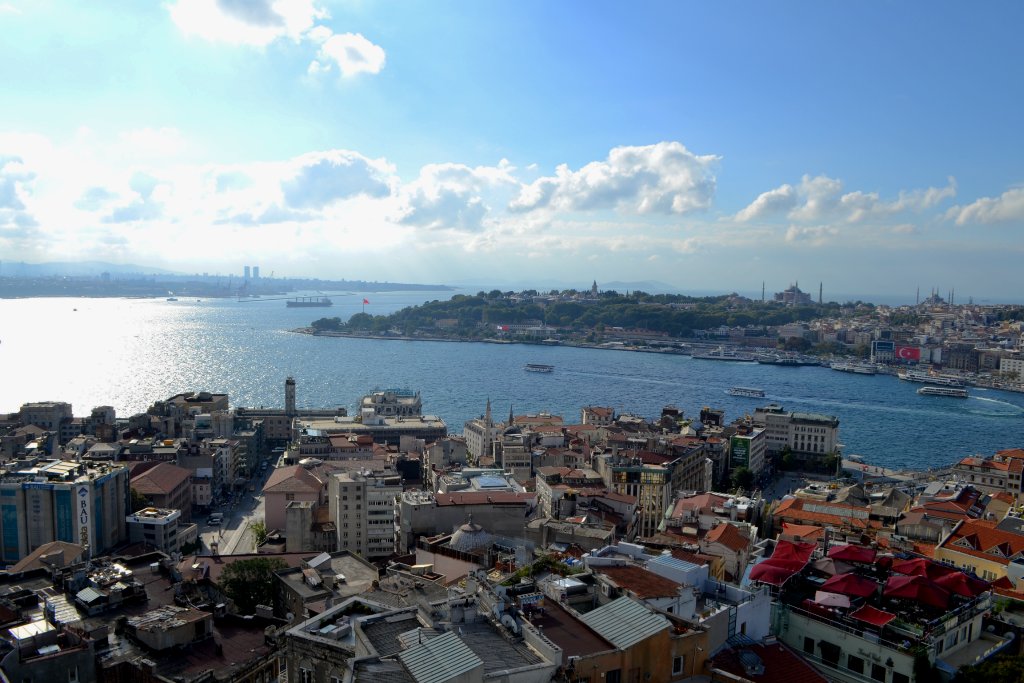
Map of Istanbul
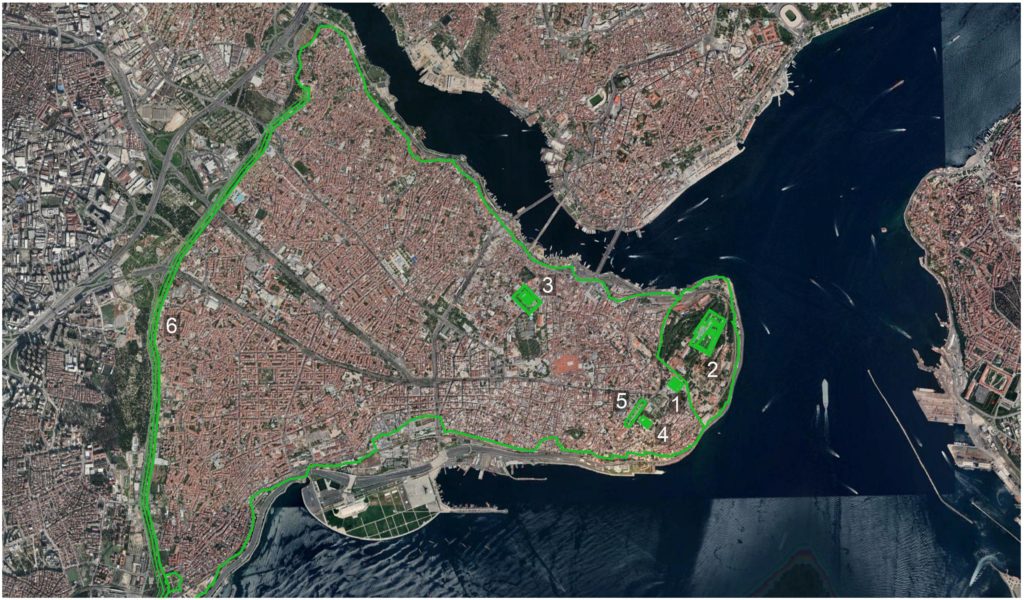
Map of Istanbul highlighting some of the city’s main attractions.
1. Hagia Sophia
2. Topkapi Palace
3. Süleymaniye
4. Blue Mosque
5. The Hippodorome / Sultanahmet Square
6. Walls of Constantinople
Table of Contents
The Waters Surrounding Istanbul
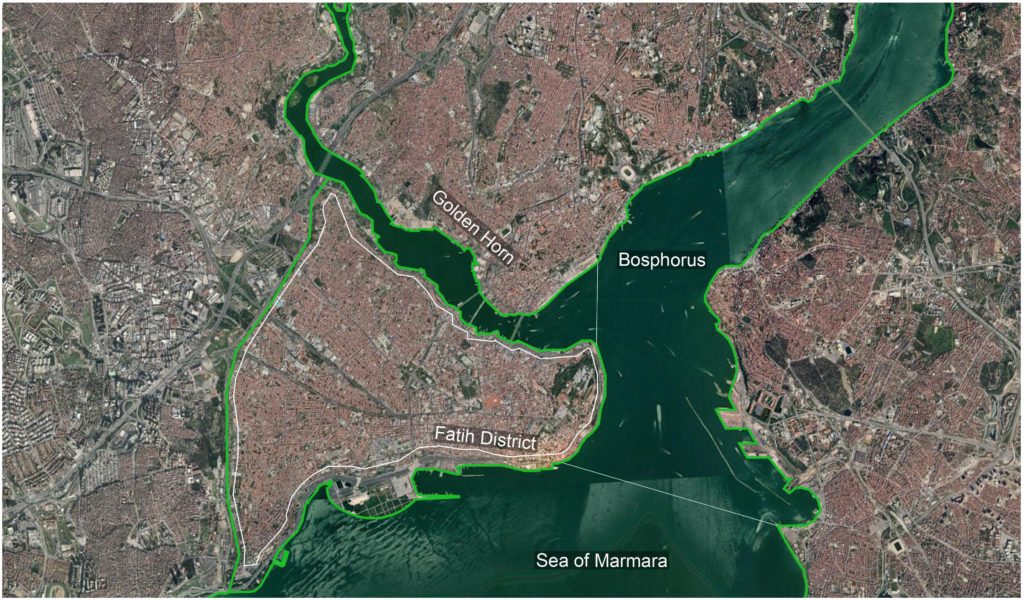
Map Showing the Various Bodies of Water Around Istanbul. The historic core of Istanbul sits between the Golden Horn, the Sea of Marmara, and the Bosphorus.
The Walls of Constantinople

Maps Data: Imagery © 2022 Maxar Technologies, Map Data ©2022 TerraMetrics, Map Data ©2022 GoogleMaps
Map Showing the Ancient Walls of Constantinople. Much of the original structure can still be seen in the city today.
History of Istanbul
Evolution of the Pendentive Dome
Throughout the Architecture of Istanbul there is one element that unifies the entire city: the Pendentive Dome. The pendentive dome originated in Byzantine buildings like the Hagia Sophia, and the Hagia Irene. After the Ottomans took over, they studied the older buildings of the Byzantines and learned how to recreate these ancient structures. Virtually every mosque in Istanbul is built in the classic Ottoman style: with a pendentive dome over a large prayer hall. The Pendentive Domes of Istanbul can be broken down into three main types, each of which is explained detail below.
- Type 01
- (4) Flat Walls
- Nuruosmaniye Mosque
The simplest form of the pendentive dome is when the dome sits atop four flat walls. Although this method is more limiting structurally, it allows the most natural light to enter the central space.
- Type 02
- (2) Flat Walls & (2) Half-Domes
- Hagia Sophia
Another form of the pendentive dome is when the dome sits atop two flat walls and two half domes. This method lets in lots of light through the flat walls, and the half-domes also help carry the weight of the large central dome.
- Type 03
- (4) Half-Domes
- Blue Mosque
The final form of the pendentive dome is when the central dome sits atop four separate half-domes. This setup really distributes the weight of the central dome and it also creates the largest interior space.
Roman & Byzantine Architecture in Istanbul
Because of its long history as a Roman city, Istanbul is filled with many incredible examples of Roman and Byzantine Architecture. The Byzantine Empire peaked during the reign of Justinian the Great, who ruled from 527 to 565. During his reign, the Hagia Sophia was completed along with several other churches such as the Hagia Irene. Several different dynasties would rule over the empire during the following centuries, including the Heraclian and Komnenid dynasties. The power of the Byzantine Empire would rise and fall over time, but Constantinople consistently remained a leading global city and one of the wealthiest trading centers in the Mediterranean. The city had a population that mostly spoke Greek and Latin, and most of its citizens were devout Eastern Orthodox Christians. Today most of the Roman and Byzantine Architecture within Istanbul is concentrated within the historic core of the city, in the district known as Fatih.
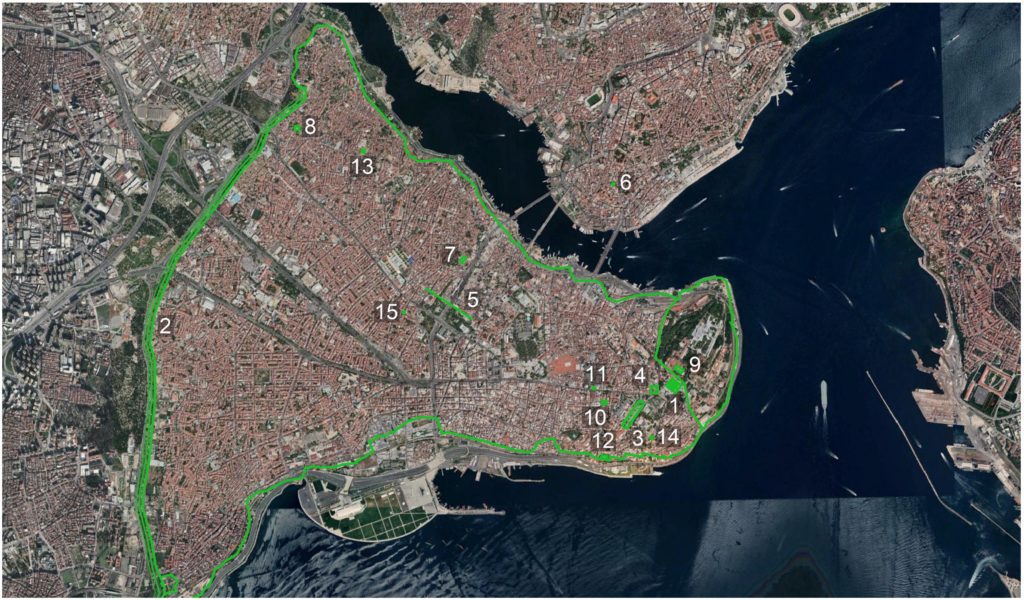
Map of Istanbul highlighting the most notable works of Byzantine Architecture within the city.
1. Hagia Sophia
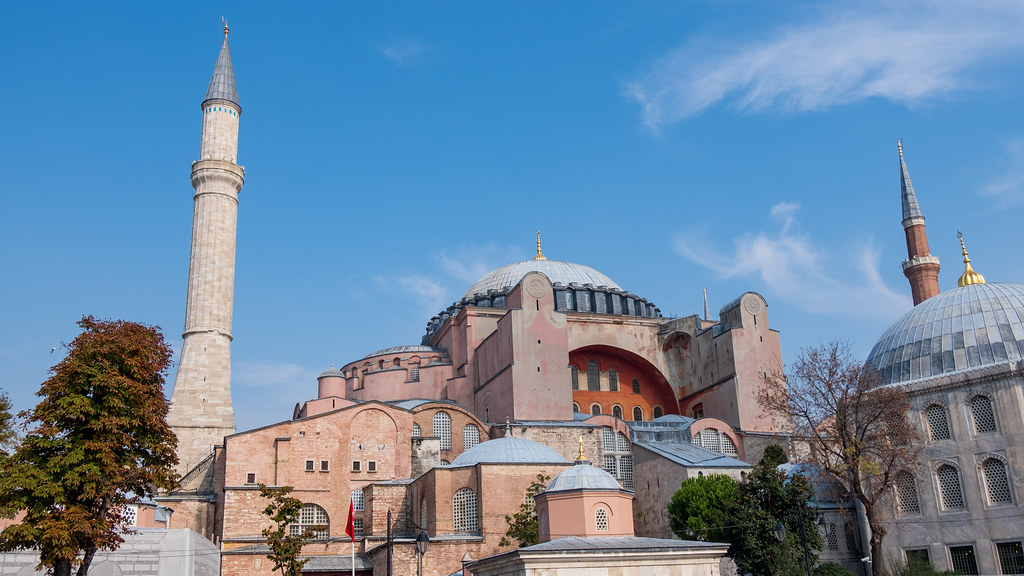
The Hagia Sophia was built during the reign of Emperor Justinian the Great, one of the most notable rulers of the Byzantine Empire. It’s often regarded as the greatest work of Byzantine Architecture ever completed, and it’s located in the heart of the historic center of Istanbul. The church was the most ambitious pendentive dome ever constructed by the Byzantines, and its design was replicated countless times by later Ottoman architects. The church utilizes two half-domes to spread the weight of the massive central dome. At the time of its completion, it was the largest dome in the world, surpassing that of the Pantheon in Rome. It wasn’t until the completion of Brunelleschi’s dome at Florence Cathedral that the Hagia Sophia lost the title of “world’s largest.”
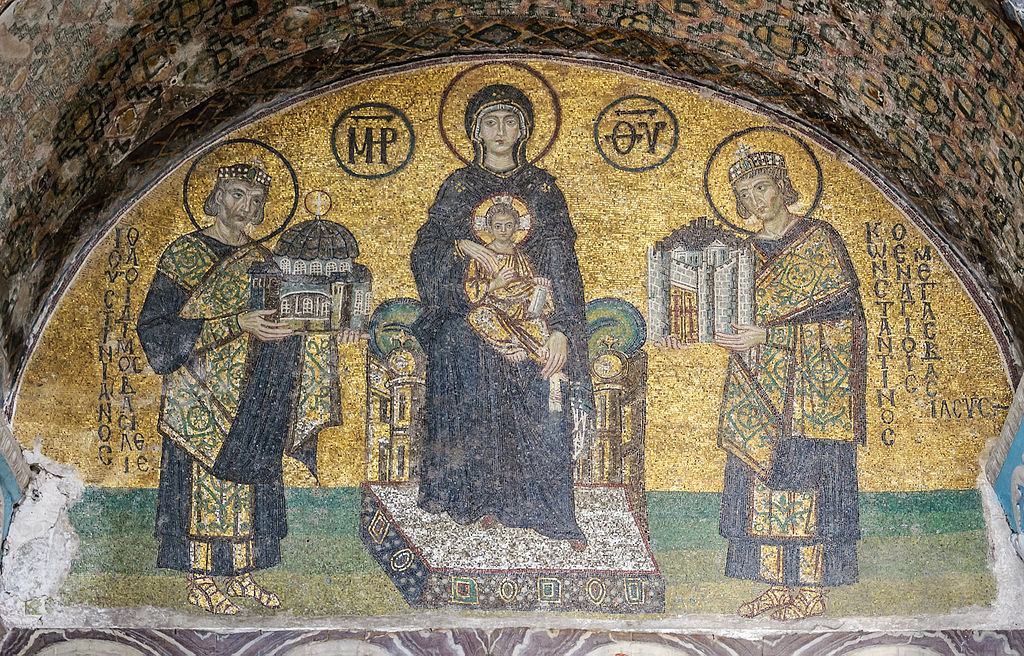
The interior of the Hagia Sophia was decorated with all of the typical elements found in Byzantine Architecture. In the image above you can see some of the signature Byzantine Mosaics found throughout the building. These mosaics are built from thousands of glass tiles in various colors, many of them containing real gold. In addition to mosaics, the church contains large pieces of mirrored marble slabs and intricately carved column capitals. The Hagia Sophia was constructed in a relatively short timeframe of just 5 years and 10 months and was completed in 537 CE.
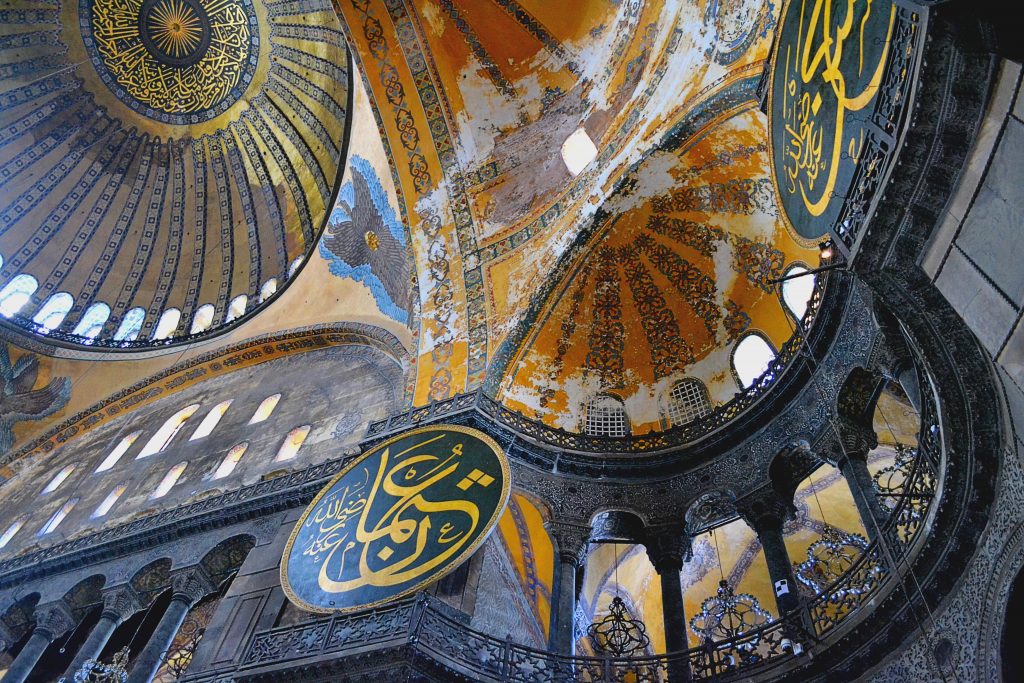
The Hagia Sophia was the church at the center of the Eastern Orthodox faith until 1453 when it was converted into a mosque by the Ottoman Sultan Mehmed II. The Ottoman Turks then heavily modified the building. They added four massive stone minarets to the four corners, which give the Hagia Sophia its current mosque-like appearance. Inside the Hagia Sophia, the Ottomans added numerous prayer halls, a Qibla, and many decorations containing Arabic Caligraphy.
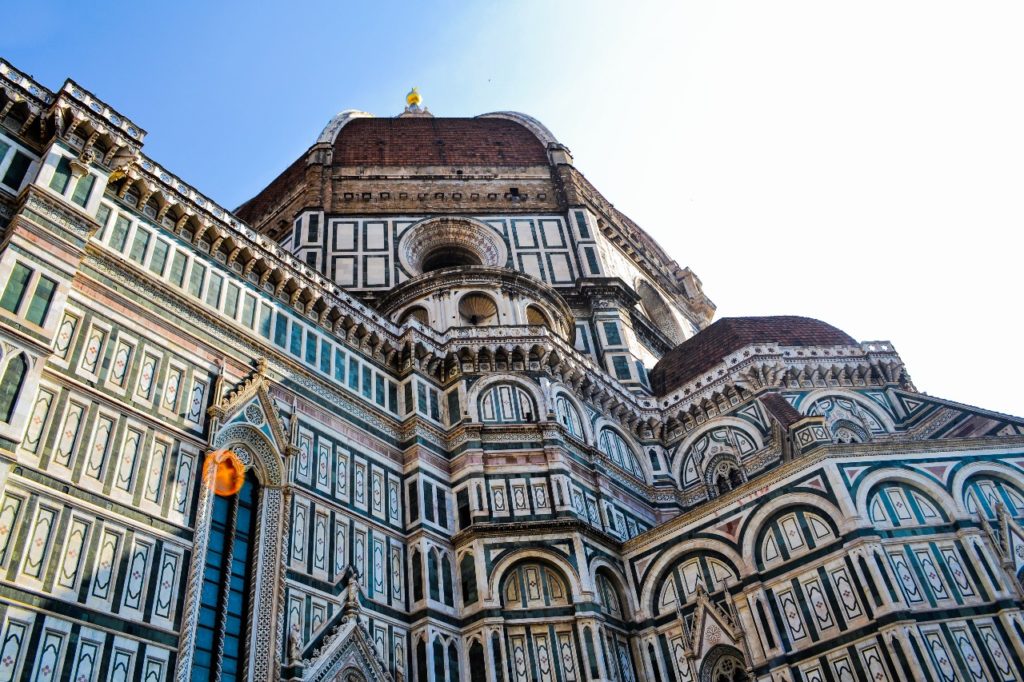
Interested in Renaissance Architecture? Check out our article on the Architecture of Florence to learn more about the birth of the Renaissance Movement.
2. Walls of Constantinople
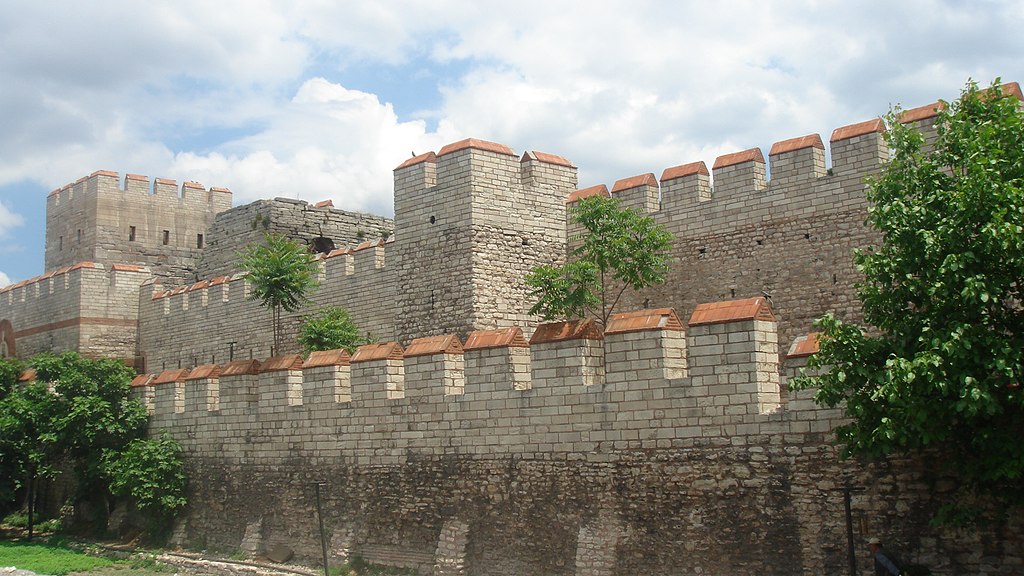
The walls of Constantinople were modified continuously over time, but the major constructions were done by Constantine the Great in the 4th century, and Theodosius II in the 5th century. The walls wrap around the entire city, creating a large land wall on the western edge, and a smaller but still formidable sea wall along the eastern, northern, and southern edges. The sea walls, which defended against naval assaults from the waters around Istanbul, were less impressive than the western land walls. Traces of them within modern-day Istanbul are often hard to find. The western land wall, which was constructed by Theodosius II from 404 to 458 CE, was a massive three-tiered system of walls, towers, and ditches that was a marvel of military architecture.
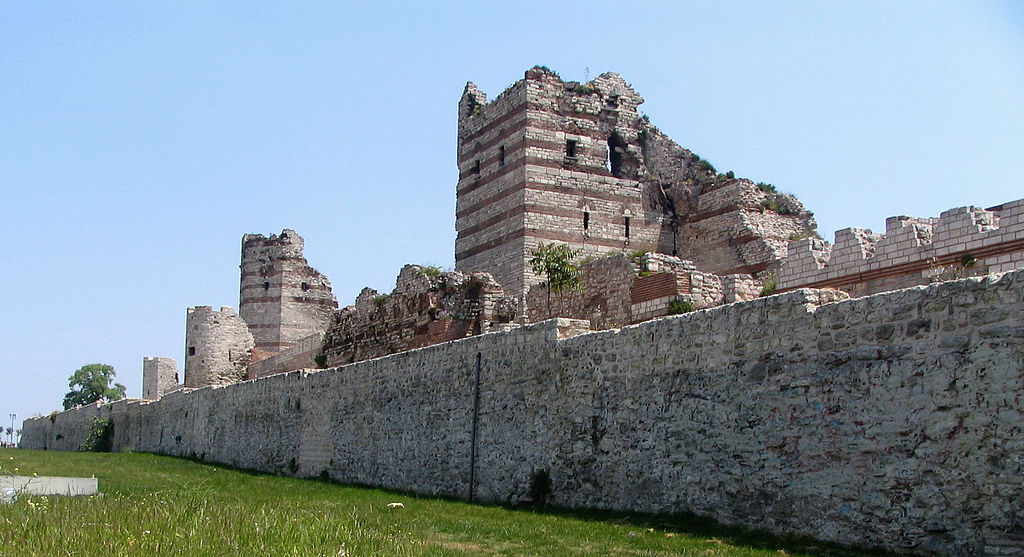
Although they helped the Byzantine Empire defend Constantinople for over 1000 years, by the 15th century, new emerging technologies were making the walls obsolete. In 1453, with the help of a vast array of cannons, the Ottoman Empire was able to conquer the city after a 7-week siege. This assault changed the course of history for Istanbul, and from then on, the city was held by the Turkish People. In the image above, you can see some of the extensive damage to the Walls of Constantinople that was likely caused by the bombardment of Ottoman cannons.
3. Hippodrome of Constantinople
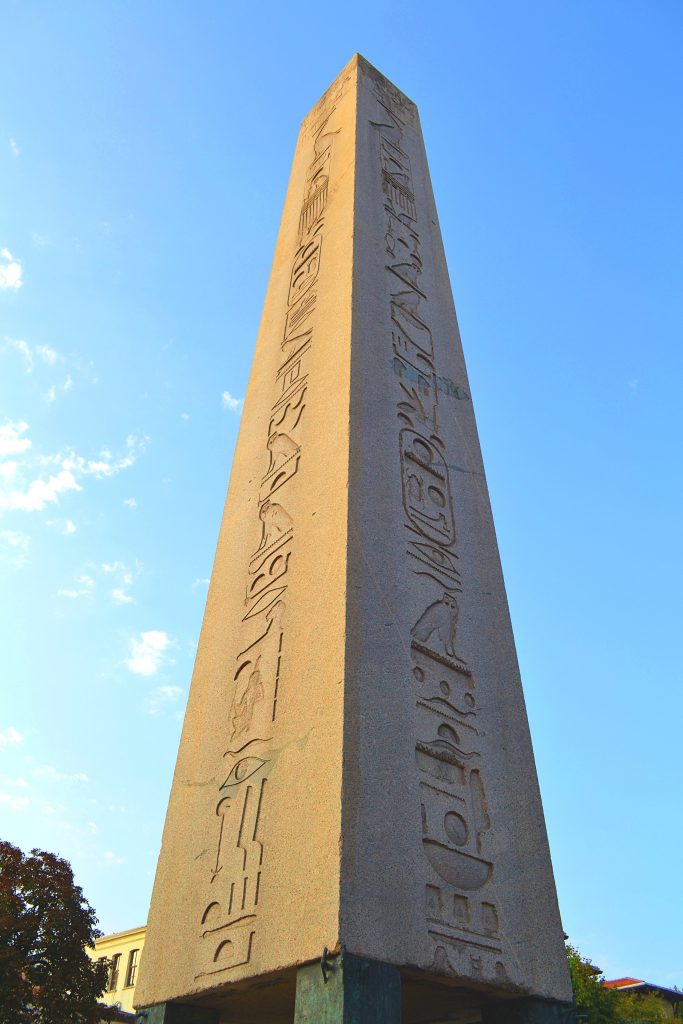
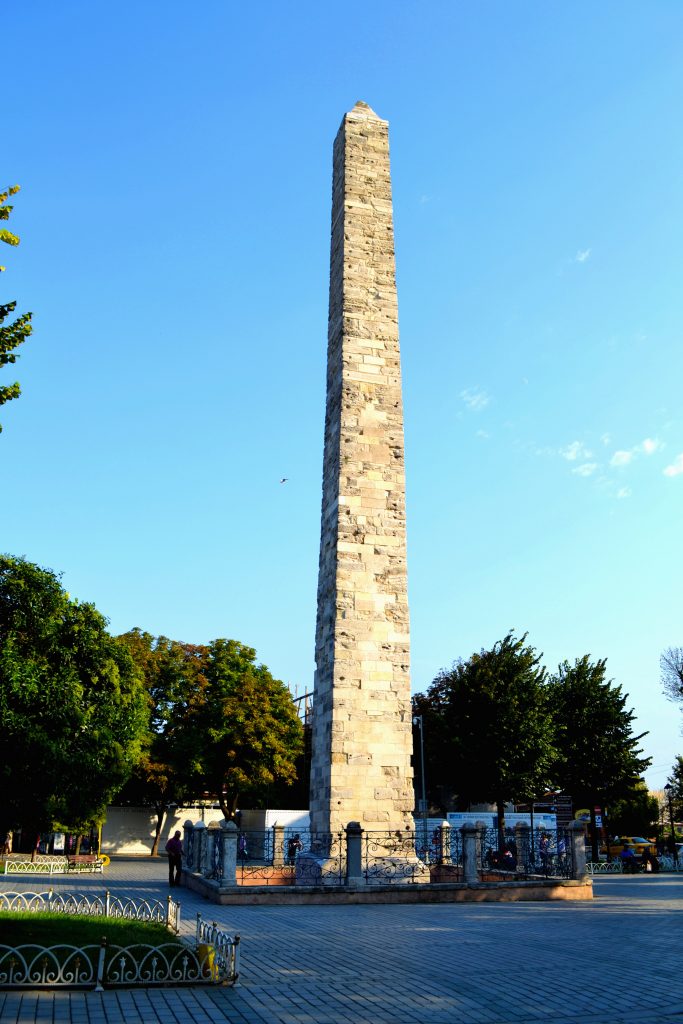
Chariot racing was a popular pastime in both the Roman Empire and the Byzantine Empire. Just like with gladiatorial combat, chariot racing required a large venue to hold the spectators. The remains of dozens of racetracks can be found all over the Roman Empire, with two of the most notable examples being the Circus Maximus in Rome and the Hippodrome of Constantinople. The Hippodrome was used for hundreds of years, with much of the construction occurring in the 3rd and 4th centuries, under the reigns of Septimius Severus and Constantine I. The best-preserved relic from the Hippodrome of Constantinople is the Obelisk of Thutmose III. The obelisk, which dates from 1490 BCE, was brought to the city by Emperor Theodosius I in 390 CE. At the other end of the racetrack is a monument, known as the Walled Obelisk. It’s a massive brick and mortar obelisk that was once completely covered with a marble veneer, although today only the bricks remain.
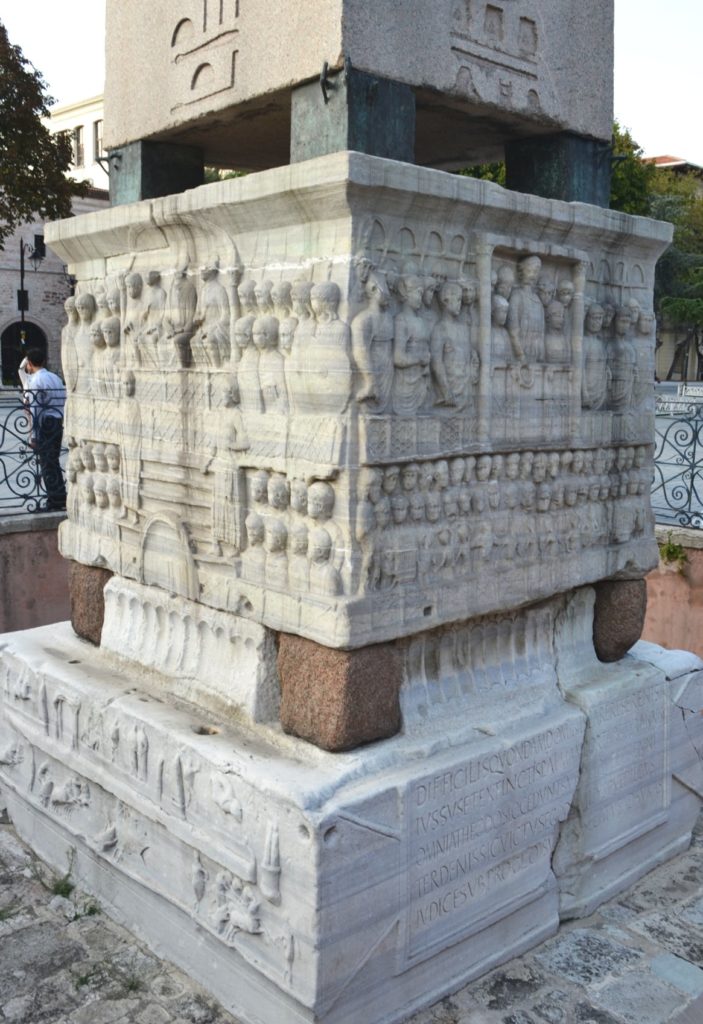
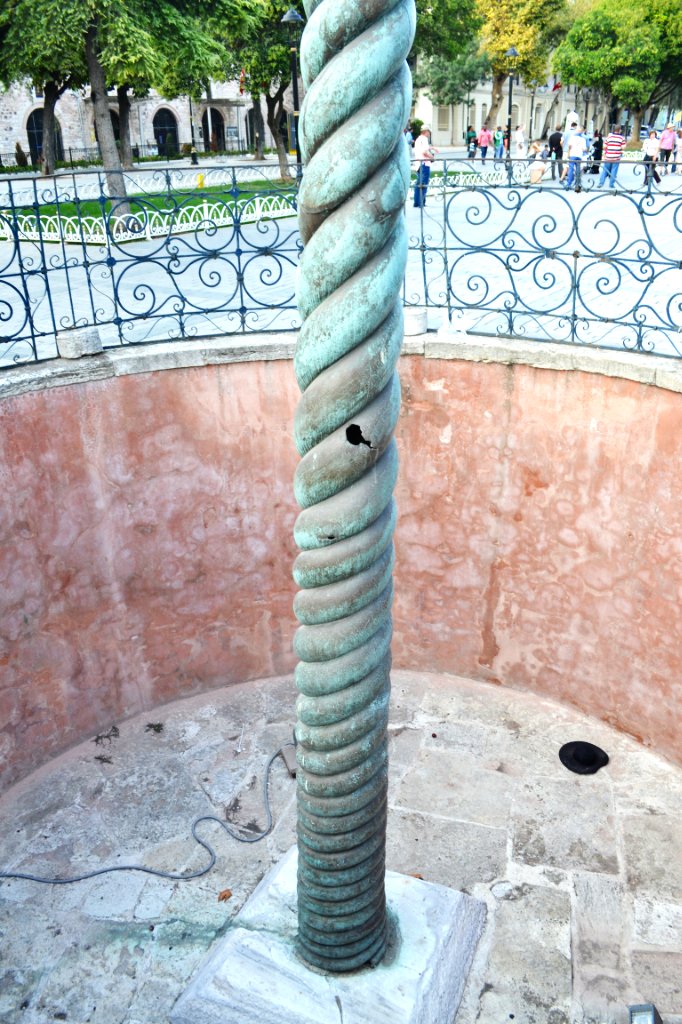
The Obelisk of Thutmose III has a base made from a massive block of white marble. The marble is elaborately carved with a Frieze depicting events from Roman History. Elsewhere within the Hippodrome, you can see the Serpent Column, a bronze statue depicting several snakes in a spiral. The column was originally located in the Greek sanctuary of Delphi, but it was later moved to Constantinople by Constantine the Great. Today not a lot of the original structure or seating within the Hippodrome remains, but the overall oval shape of the racetrack can be seen in the plan of Istanbul’s Sultanahmet Square.
4. Basilica Cistern
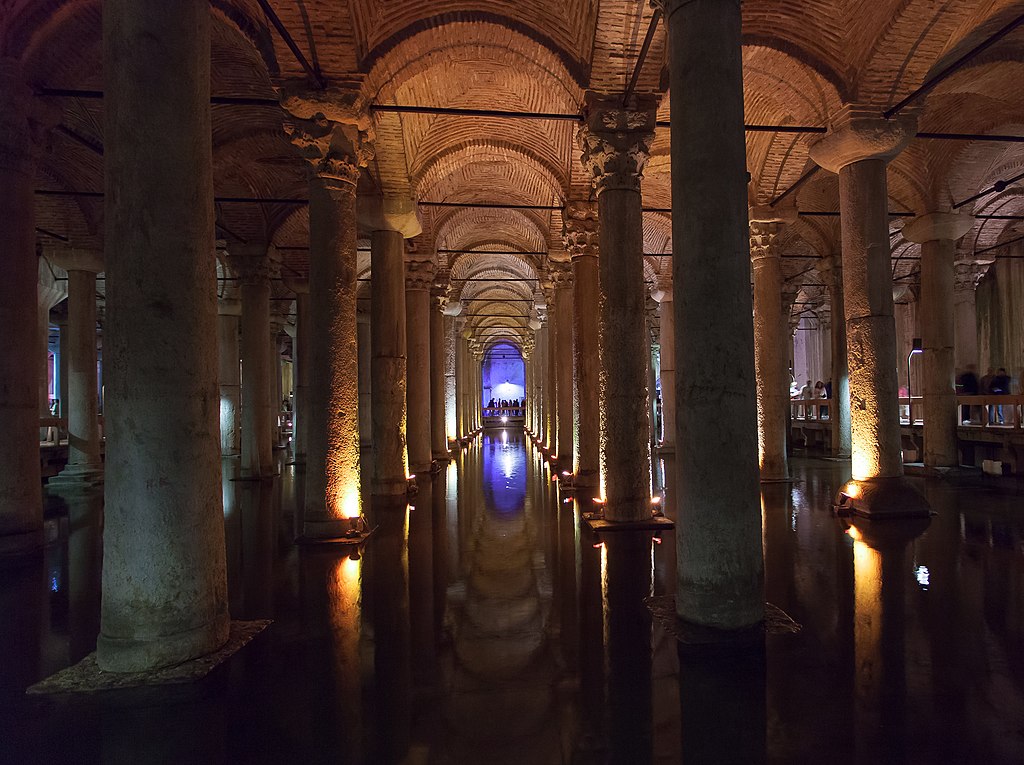
You wouldn’t know it while walking around the streets of Istanbul just outside the Hagia Sophia, but beneath your feet is a massive underground water storage tank. This cistern is named the Basilica Cistern due to its proximity to an older basilica and it’s an incredible example of Byzantine infrastructure and urban planning. The enclosed space is massive, able to hold 2,800,000 cubic feet of water or about 32 Olympic size swimming pools worth of liquid. The cistern provided water to much of the city, including the emperor’s royal residence. Within the cistern, there are 336 columns, some of which are richly decorated with column capitals, medusa heads, and ornate carvings. Today the Basilica Cistern is open to the public and visitors can walk on elevated pathways in-between the vast network of columns.
5. Valens Aqueduct

Emperor Valens ruled the Eastern Roman Empire in the late 4th century CE. During his reign, he commissioned the construction of a large Roman Aqueduct that brought in water from natural springs to the west of Constantinople. Today the aqueduct stands precariously over Atatürk Boulevard and car traffic weaves its way through the ancient stone arches. Its positioning is a constant reminder of the Ancient Roman roots of the city and how the architecture of Istanbul has been greatly influenced by both the Roman Empire and the Ottoman Empire.
6. Galata Tower
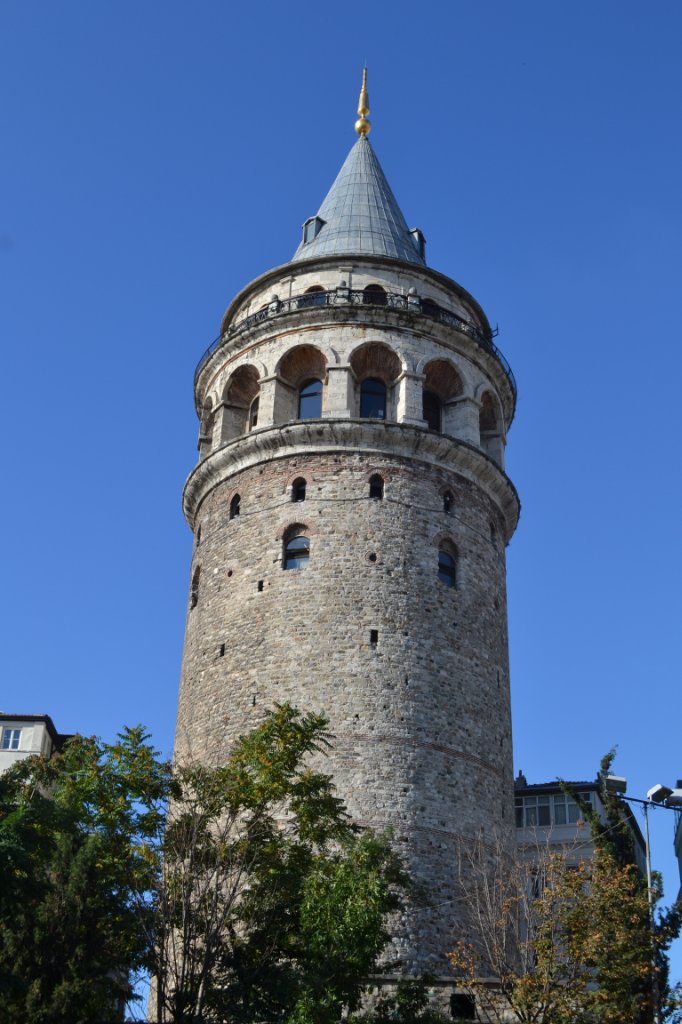
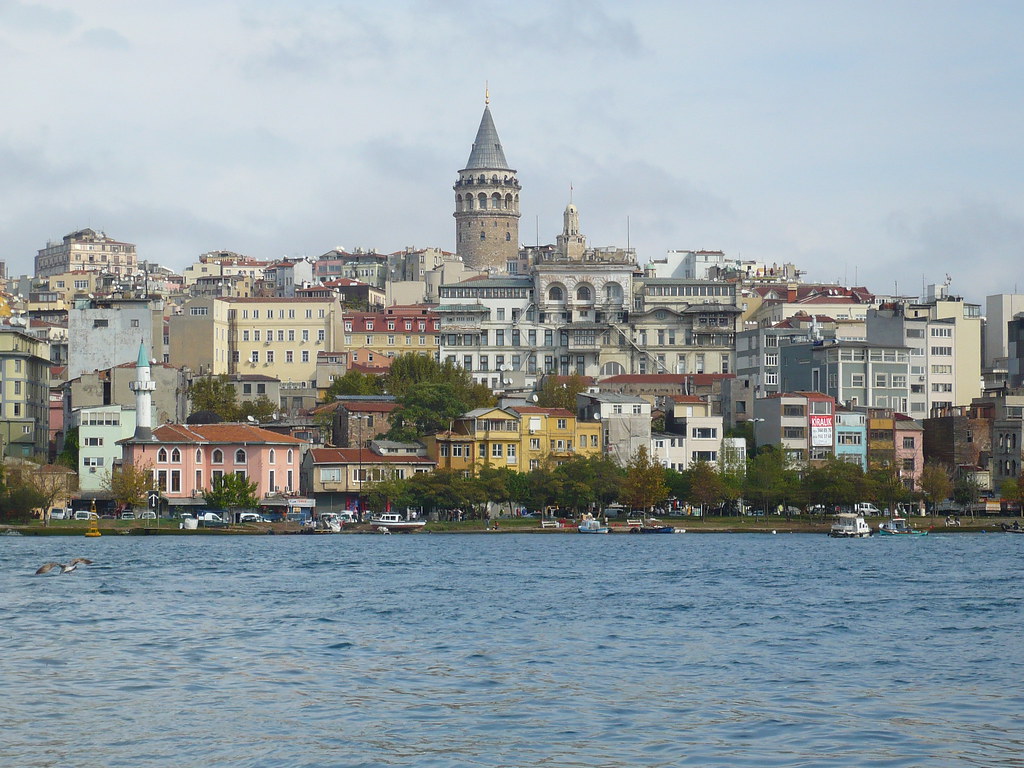
We included the Galata Tower within the Byzantine Architecture section of this article, however, it can technically be viewed as an example of Genoese Architecture within the modern-day city of Istanbul. The tower was completed in 1348, and it was designed in the Romanesque Style. It was built by Genoese merchants to protect a small trading colony they founded across the Golden Horn from the main city. The Genoese outpost, known as Galata, corresponds with the modern-day neighborhood of Galata within Istanbul, and it has since become an important area in the heart of the city.

Romanesque was Europe’s dominant architectural style from the 10th-11th century. Read our article, “Romanesque Architecture and the Top 15 Romanesque Buildings” to learn more!
7. Monastery of the Pantocrator

The Monastery of the Pantocrator is the second-largest Byzantine Religious building that still exists in Istanbul. The Monastery is actually made up of two separate churches and a smaller chapel. These buildings were all constructed using brick masonry, with mortar joints that are much wider than the bricks themselves. This technique was typically used in Byzantine Architecture from this period and can be seen in many different buildings all over Greece, Anatolia, and the Balkans. After the Ottoman conquest of Constantinople, the Monastery was converted into a mosque, and it remains as such to this day. Now called the Zeyrek Mosque, the interior of the building more closely resembles other mosques in Istanbul, but traces of older Byzantine Architecture can still be seen.
8. Chora Church

The Chora Church is another great example of the Byzantine Architecture of Istanbul. Originally it was built outside the city walls in the 4th century CE. However, in the 5th century, the Theodosian Walls were completed, which enclosed the church and surrounding areas. A lot of the structure of the church we see today was rebuilt in the 11th century after a devastating earthquake. The mosaics within the Chora Church are some of the best-preserved in Istanbul thanks in large part to modern-day restoration efforts.
9. Hagia Irene
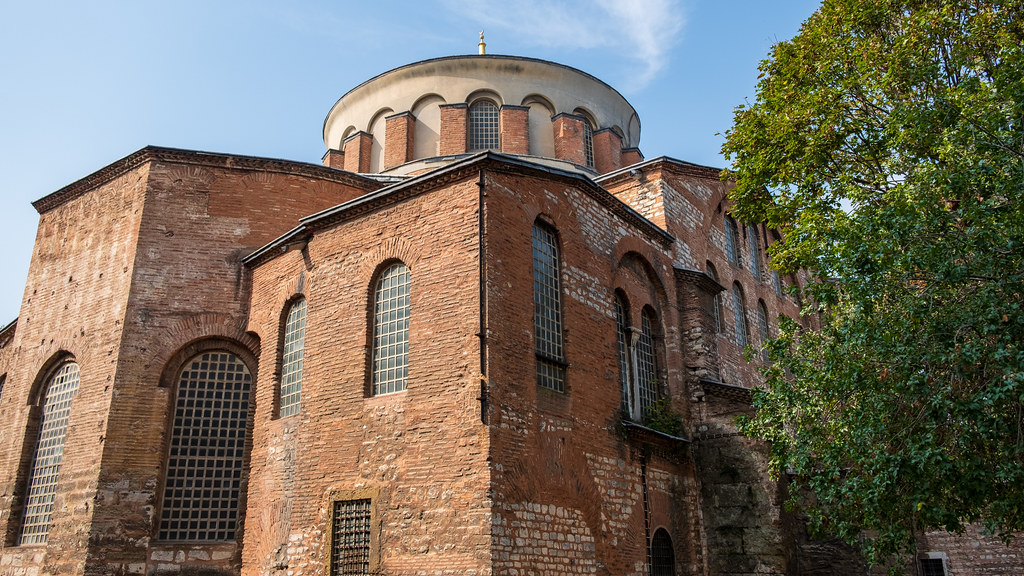
The Hagia Irene is one of the oldest churches in modern-day Istanbul. It was built on the foundation of an earlier pagan temple dating from the days of the Roman Empire. The first church was built on this spot during the reign of Emperor Constantine I, but it later burned down. In 532 CE Emperor Justinian I had the church rebuilt. Although significantly smaller than the nearby Hagia Sophia, the Hagia Irene is very similar in style and construction. The church is built from a series of arches and vaults, which hold up a large dome. This technique was revolutionary at the time and was replicated constantly throughout Byzantine Architecture.
10. Theodosius Cistern

Just like the Basilica Cistern listed above, the Theodosius Cistern was a large underground basin meant to store water for the ancient city of Constantinople. The cistern was built by Emperor Theodosius II and the water was supplied by the Valens Aqueduct. The roof of the cistern is supported by 32 marble columns connected by vaults and arches to support the street level of Istanbul above. Today the cistern is open to the public after a restoration project that took nearly a decade. The cistern itself looks almost like a cyborg of some sort, with various metal bars and rings added to all of the columns in order to provide extra support to the 1500-year-old construction.
11. Column of Constantine
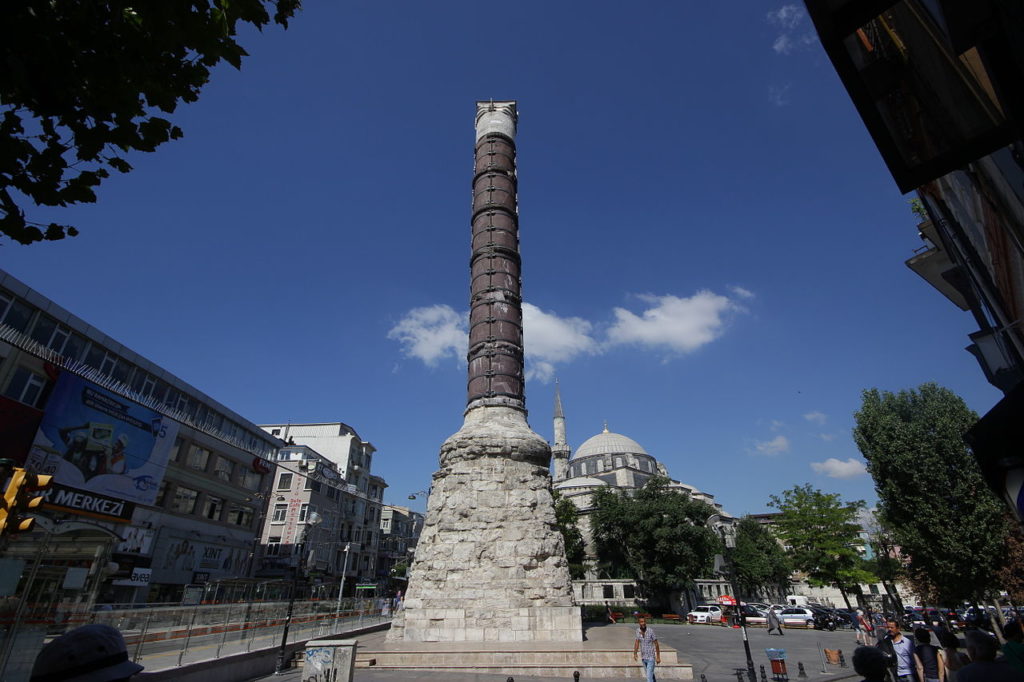
The Column of Constantine is a Roman Triumphal Column located within the heart of Istanbul’s historic center. It commemorates emperor Constantine who was regarded as a savior of the Roman Empire. He helped reorganize Rome and brought the empire into a state of prosperity after a long period of chaos and political instability. The column once stood in the center of a large Roman Forum which has since been lost within the streetscape of modern-day Istanbul. In the background of the image above, you can see the Gazi Atik Ali Pasha Mosque, a great example of the Ottoman architecture of Istanbul.
12. Little Hagia Sophia

The Little Hagia Sophia is an example of an early Byzantine dome built in Istanbul. The Byzantines constructed many smaller churches before the completion of the Hagia Sophia, which helped them learn the skills to create larger and grander domes. The term “Little Hagia Sophia” is a nickname that eludes to the evolution of this type of building. Many historians believe the Little Hagia Sophia served as a sort of model for the larger Hagia Sophia. Today the Little Hagia Sophia is a functioning mosque, and the interior has been completely redecorated. The white-washed walls and the blue-colored tiles are key elements found throughout the Ottman Architecture of Istanbul.

Gothic was the dominant architectural style in Europe during the early Middle Ages. Check out our article on the Top 25 Examples of Gothic Architecture to learn more!
13. Pammakaristos Church
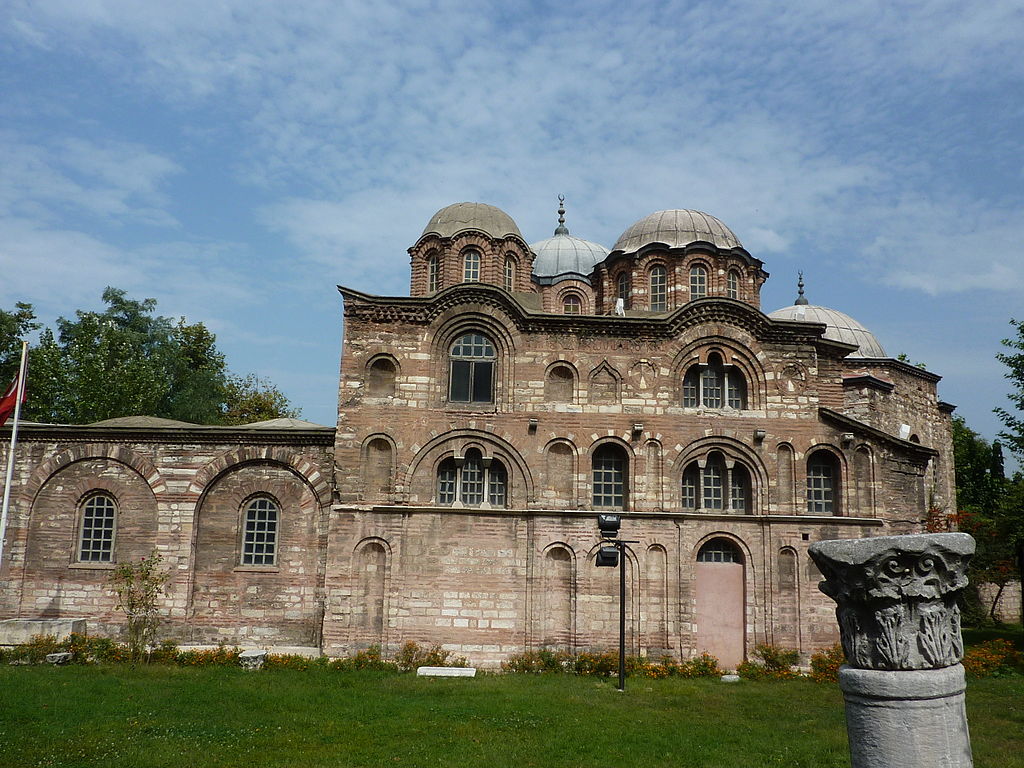
Pammakaristos Church is another old Byzantine Church with an original foundation dating back to the 11th century. Its located on the northern side of the city center, within the Theodosian Walls. Like Chora Church, Pammakaristos Church is known for its many Byzantine Mosaics. Throughout the Middle Ages, Byzantine Craftsmen traveled far and wide to complete mosaics throughout the empire and within other European kingdoms. Today many cities including Florence, Venice, Ravenna, and Rome all contain stunning examples of Byzantine Style Mosaics.
14. Great Palace Mosaic Museum
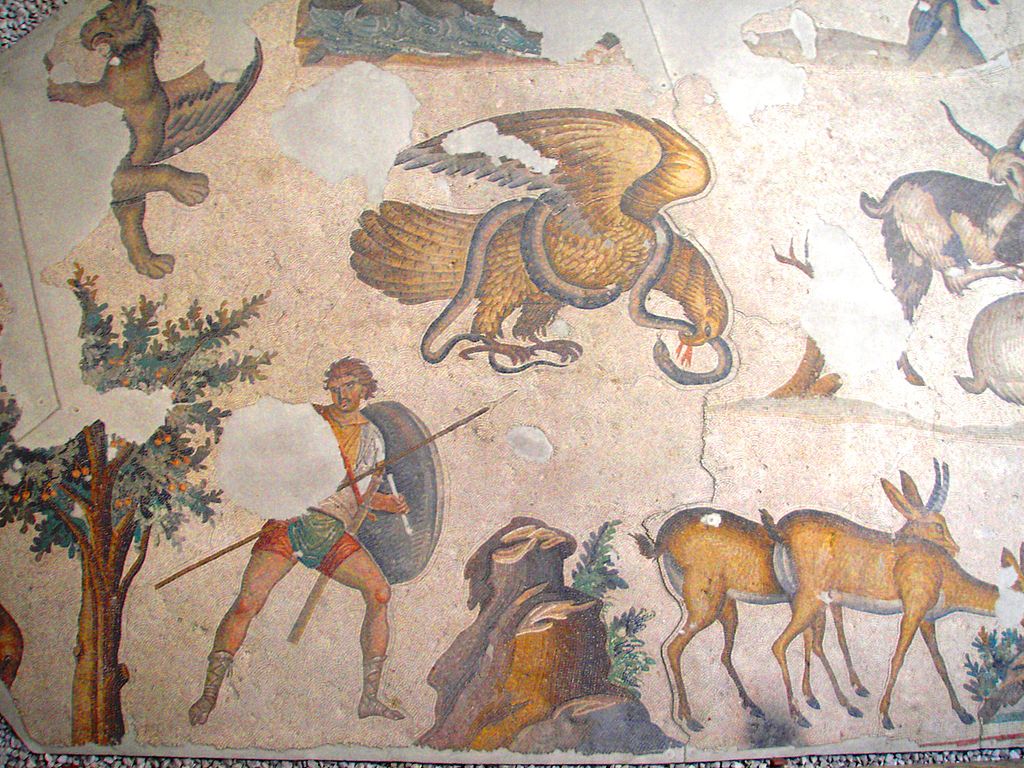
The Great Palace Mosaic Museum is located right next to the Blue Mosque in central Istanbul. The building itself isn’t from the Eastern Roman era, but the art within it was excavated from the Great Palace of Constantinople. The palace once stood right next to the Hippodrome and the Hagia Sophia, but it was completely demolished after the Ottoman conquest. Some of the remains of the Great Palace can be found here at the Palace Mosaic Museum, and also at the Istanbul Archeological Museum.
15. Column of Marcian

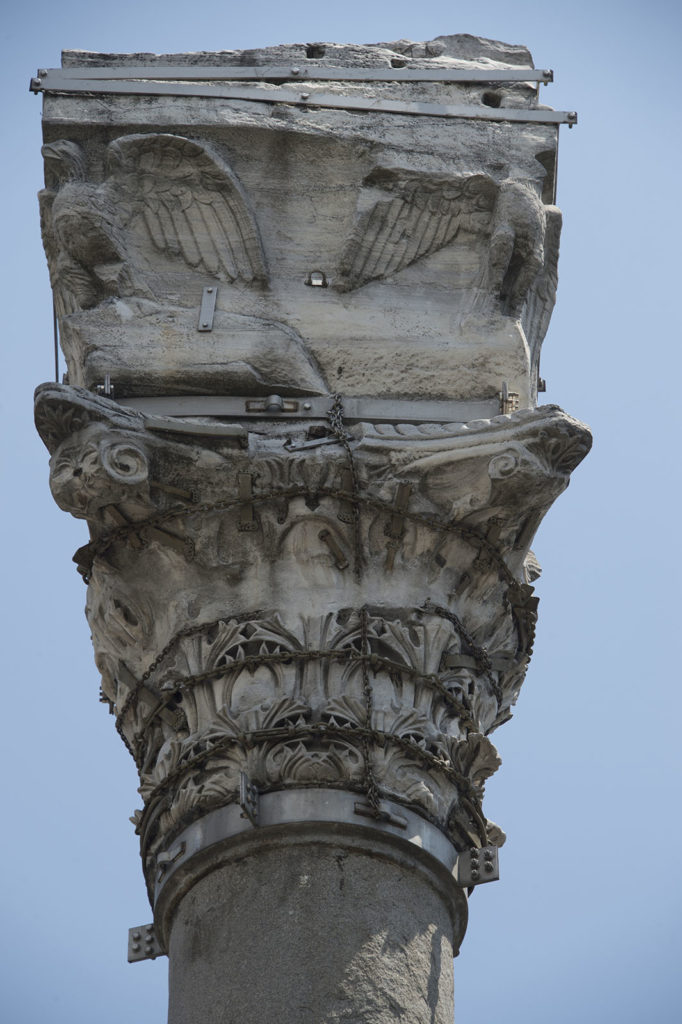
Right Photo by Dosseman from Wikimedia Commons
The Column of Marcian is a Roman Triumphal Column dedicated to Emperor Marcian, who ruled from 450-457. Marcian ruled at a time when Constantinople was the capital of the Eastern Roman Empire, before the fall of Western Rome. The column has suffered a great deal of erosion over the centuries. Today it is so damaged, that it can only stand with the help of multiple steel structural braces. Despite the modern modifications, the Column of Marcian is still a great example of the presence of the Ancient Romans within modern-day Istanbul.
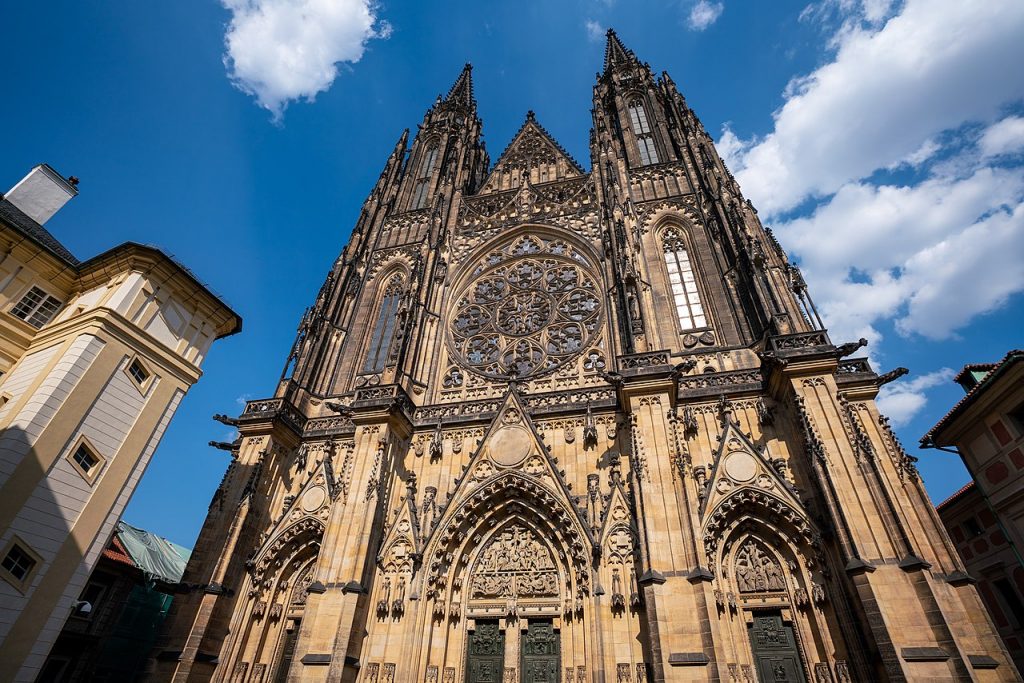
Interested in Prague? Read our article on the Architecture of Prague to learn more!
Ottoman Architecture in Istanbul
The Ottoman Empire originated in the 13th century in Western Anatolia. They quickly became a dominant power in the region and took over large portions of Byzantine territory. By the early 1400s, the Ottomans gained control of the area west of Constantinople on the European mainland. Although other Ottoman Sultans had failed before him, Sultan Mehmed II decided to attack the city and bring it under Ottoman control. Shortly after his successful siege in 1453, Constantinople would be made the capital of the Ottoman Empire. The Ottomans converted all of the city’s churches into mosques, and they replicated older Byzantine Architecture to create new mosques featuring large Pendentive Domes.

Map of Istanbul highlighting the most notable works of Ottoman Architecture within the city.
Note: #23 on the list is not depicted.
1. Süleymaniye Mosque
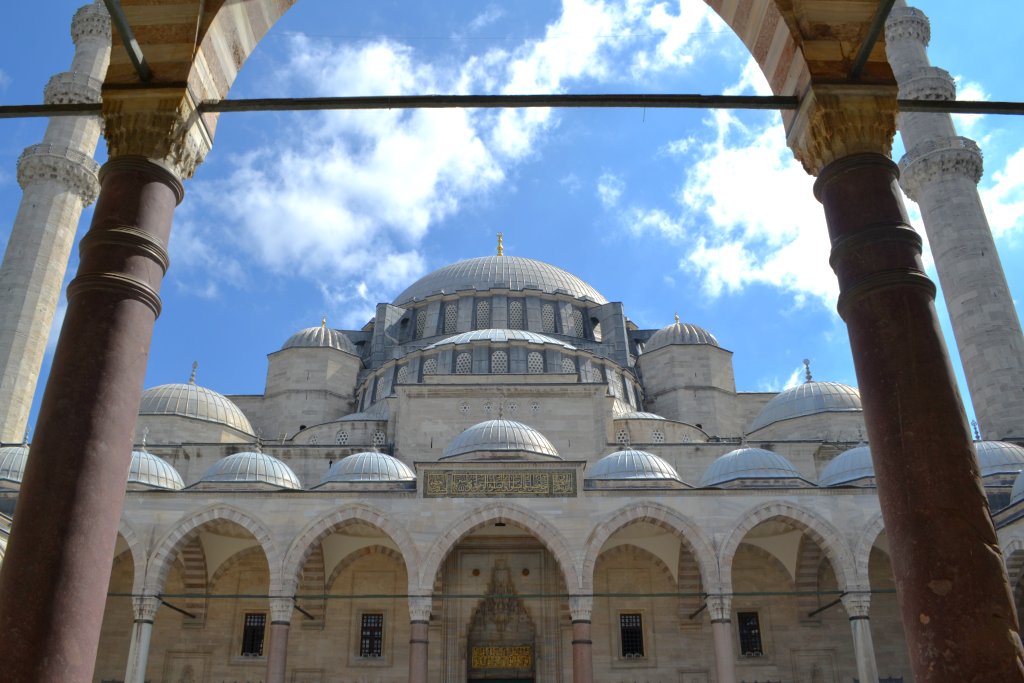
One of the great architects of the Ottoman Empire was Mimar Sinan. He worked throughout the 1500s, completing some of the Ottoman Empire’s most daring projects. Mimar studied the Pendendtive Dome throughout his entire career, and he was still creating new mosque designs well into his 90s. Süleymaniye is considered to be Mimar Sinan’s greatest work. It’s the largest and most lavish mosque Sinan ever designed, and it’s a direct evolution of many of his previous buildings. Süleymaniye was commissioned by Suleiman the Magnificent, one of the empire’s greatest Sultans. He ruled from 1520 to 1566 during the peak of Ottoman dominance and power.
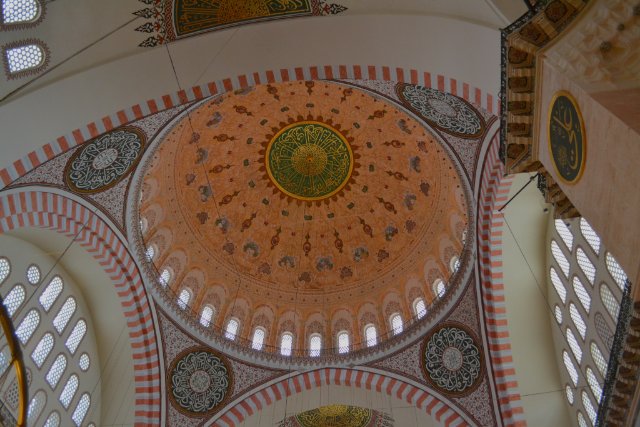

The design of Süleymaniye features a massive pendentive dome, which sits on two half domes and two flat walls. This design replicates the same structure found at the Hagia Sophia and it’s one of the three main ways that both the Ottomans and the Byzantines constructed Pendentive Domes. This option creates a large open space that still has a lot of light coming in through the windows on the flat walls. Some argue that Mimar Sinan and Suleiman wanted to create a building that exceeded the beauty and elegance of the Hagia Sophia. Thanks to its position on a large central hill, Süleymaniye can be seen from all over the city and it is one of the most emblematic buildings in Istanbul.
2. Topkapı Palace

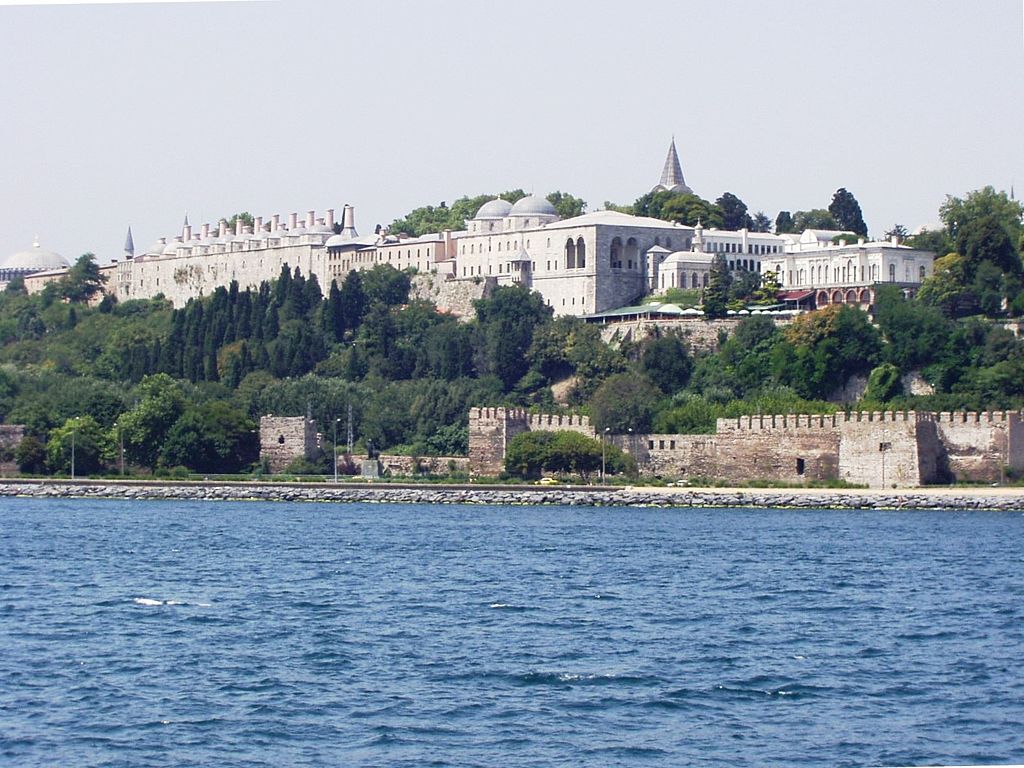
Like all great ruling dynasties, the Ottoman Sultans spent a great deal of money and energy on their royal residences. From the 15th century until 1853 Topkapı Palace served as the home of the Sultan and his family. The palace itself is a labyrinth of different buildings, constructed at various points in history. One of the most impressive spaces within the palace is the Imperial Hall, which you can see in the left image above. It contains the imperial throne and is decorated with light blue tiles, fine furniture and ceramics, and lavish floor rugs. Topkapı Palace also contains several decorated pavilions named for cities in the Ottoman Empire, such as the Baghdad Kiosk and the Yerevan Kiosk.
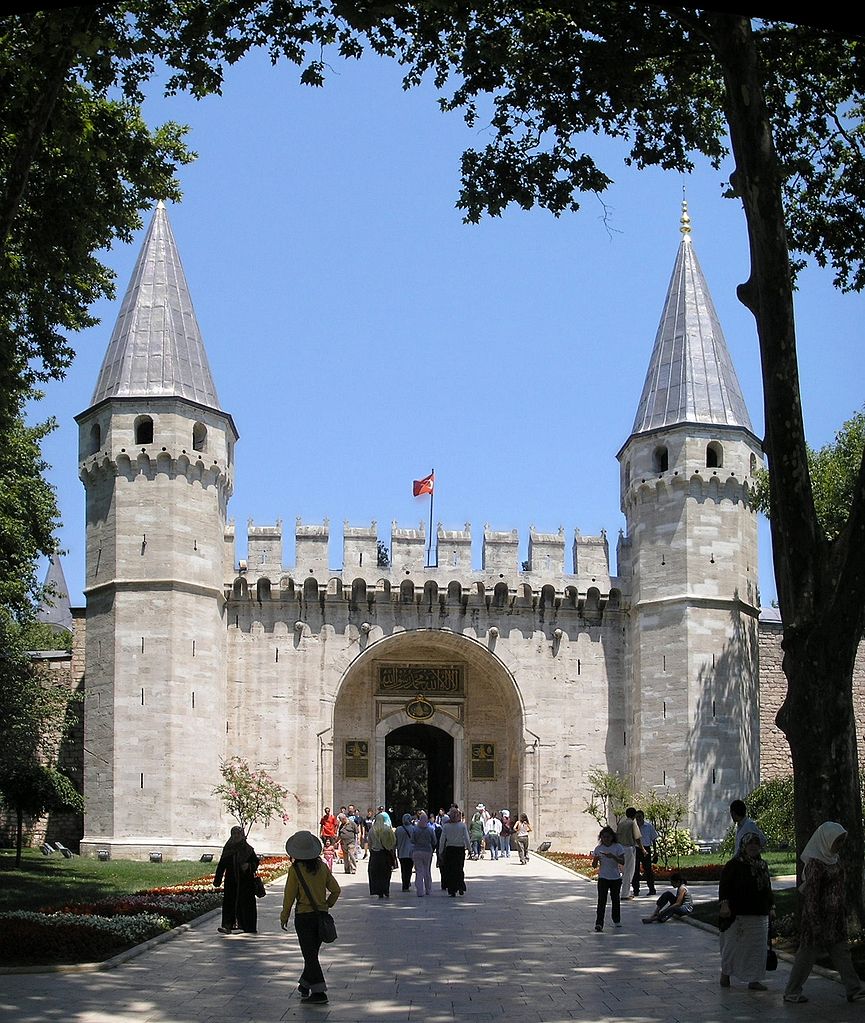
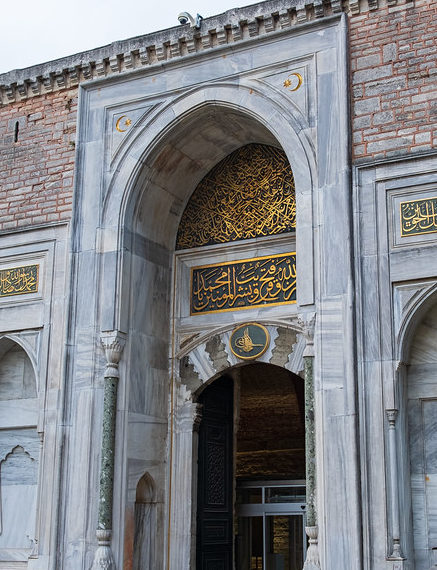
Topkapı Palace is located on the eastern edge of Istanbul’s historic center, in an area that was well protected by the city’s original fortifications. Eventually, in the late 19th century the Ottoman Sultan’s built several new palaces outside the city center on the shores of the Bosphorus. Although these new structures contained more modern comforts like plumbing and electricity, Topkapı Palace still remains the most iconic residence of the great sultans. Today most of the building has been converted into a museum, and visitors are free to roam the palace halls and gardens and enjoy pristine views of the waters around Istanbul.
3. Sultan Ahmed Mosque (Blue Mosque)

Sultan Ahmed Mosque, colloquially known as the Blue Mosque, is another one of the many incredible examples of Ottoman Architecture in Istanbul. As its name suggests, it was built by Sultan Ahmed I, who ruled the Ottoman Empire from 1603 to 1617. The Mosque is located in the eastern portion of the city’s historic center, overlooking Sultanahmet Square and a short walk from the Hagia Sophia. The Blue Mosque is of the typical Ottoman design, with a large enclosed courtyard, several towering minarets, and a massive prayer hall sitting beneath a pendentive dome. Unlike at Süleymaniye, the Dome of the Blue Mosque sits atop four half domes. Each of which helps distribute a quarter of the weight of the central dome outward onto several buttresses.

Sultan Ahmed Mosque is referred to as the Blue Mosque thanks to the multitude of blue-colored tiles decorating the interior. Most of these tiles feature patterns and calligraphy, and the same light-blue color is found throughout. This particular shade was eventually described as Turquoise, which loosely translates to “the color of the Turks.” Decorative tiles can be found throughout the world of Islamic Architecture and are a major component in many Islamic buildings. They typically feature shapes and calligraphy because of customs in Islamic Art that forbid the depiction of people, places, and animals.
4. Dolmabahçe Palace
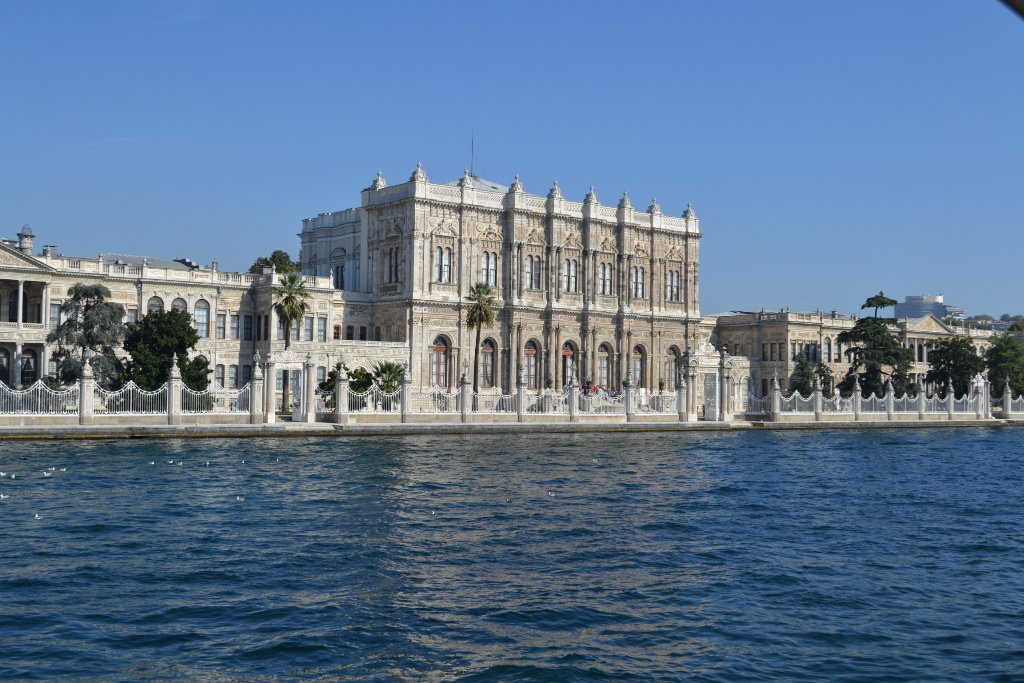
Dolmabahçe Palace is one of several grand palaces constructed by the late Ottoman Sultans. It opened in 1856, and immediately served as a royal residence and the general administration center within the Ottoman Empire. The design of the building follows many of the traditional ideas of the Revival Era from the 19th century. There are elements borrowed from traditional Baroque, Rococo, and Ottoman Architecture. Dolmabahçe Palace is located north of the city center, on the European side of the Bosphorus Strait. This area is dotted with a few different Ottoman Palaces from the same era, including Çırağan Palace and Beylerbeyi Palace.
5. New Mosque
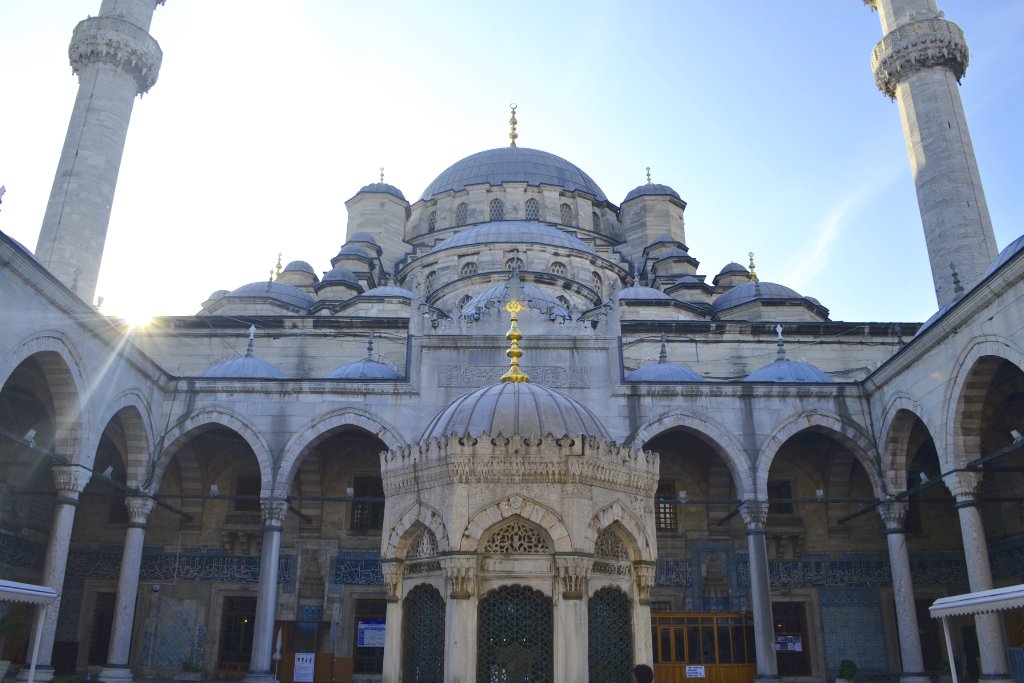
The New Mosque is another incredible work of Ottoman Architecture within Istanbul. Construction began on the structure in 1597 and was carried out in phases until the 1660s. The mosque stands in the historic center of Istanbul, overlooking the waters of the Golden Horn. The New Mosque is emblematic of the role women had within the day-to-day operations of the Ottoman Empire. The construction of the mosque was administered by two important women. The first was the wife of Sultan Murad III, and the second was the mother of Sultan Mehmed IV. Many people refer to this point in Ottoman history as the Sultanate of Women Period when power was shared amongst the men and women of the royal family.
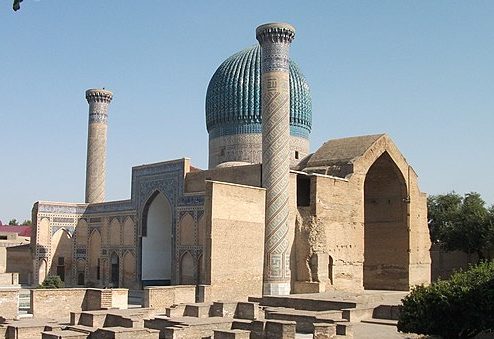
Interested in the Timurid Empire? Check out our article, “Timurid Architecture and the Timurid Renaissance” to learn more!
6. Maiden’s Tower
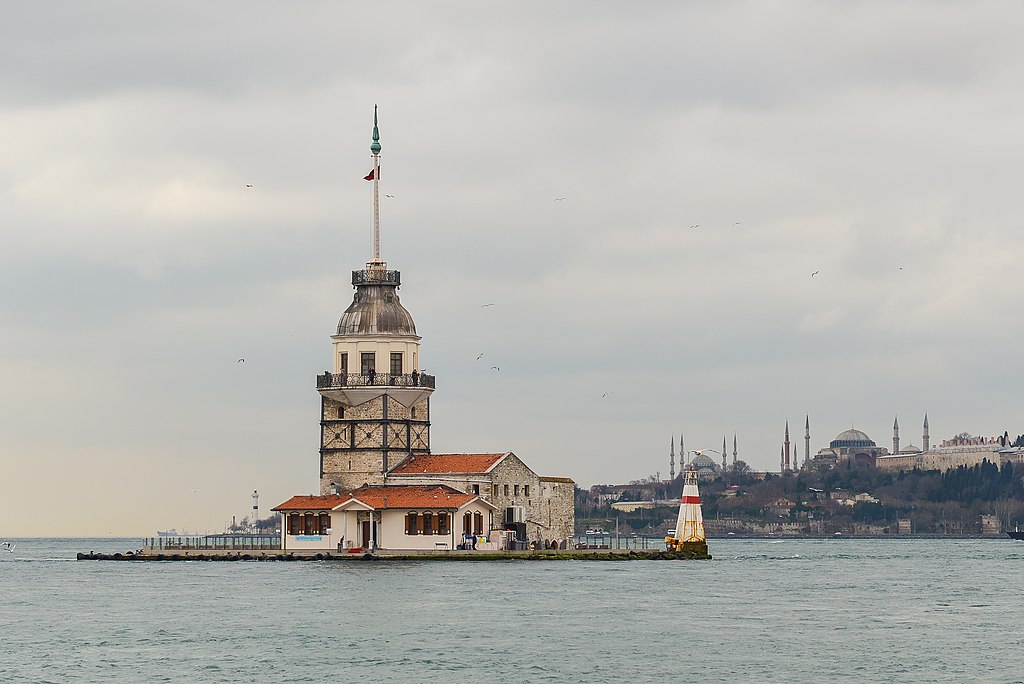
Located on a rocky outcrop within the waters surrounding Istanbul, the Maiden’s Tower is a lighthouse that dates all the way back to the Byzantine period. Although lost over time, the original lighthouse guided ships as far back as the 12th century. The current tower was completed by the Ottoman Empire in the 1700s, and it was later modified again in the 1800s. The Maiden’s Tower is extremely picturesque thanks to its positioning, and it has become one of the most recognizable landmarks in all of Istanbul. The image above shows the lighthouse, with the distant minarets of the Hagia Sophia and the Blue Mosque in the background.
7. Grand Bazaar
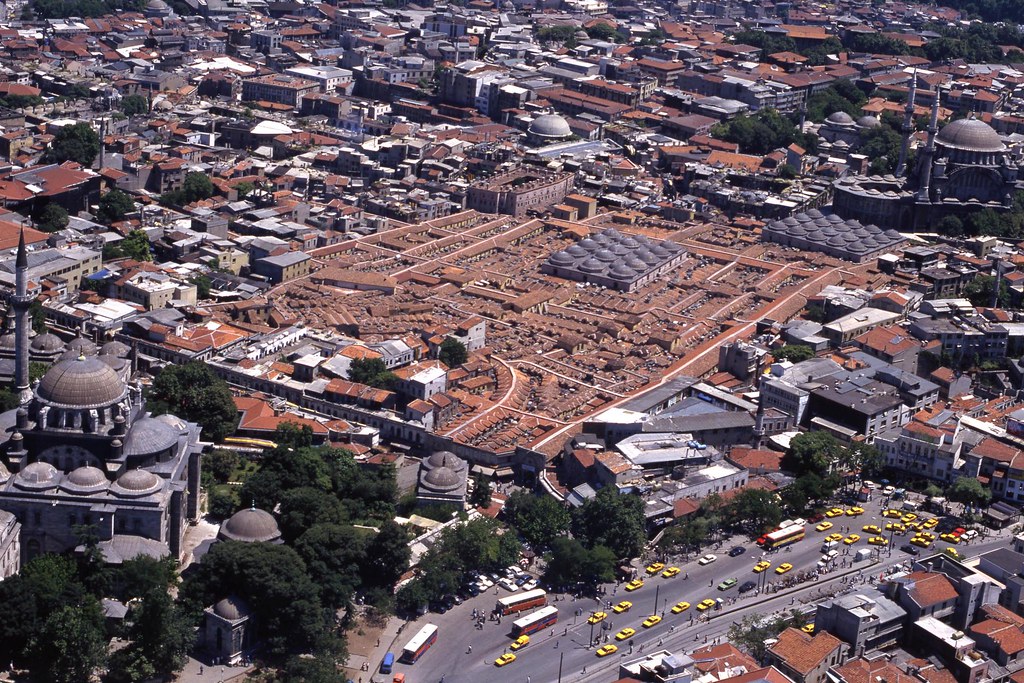
The Grand Bazaar is another one of Istanbul’s most well-known buildings. The actual structure is an array of winding corridors lined with shops and retailers. The Bazaar is constantly filled with life and energy, and visitors can buy just about anything here, including souvenirs, rugs, furniture, food, and spices. Turkey, as well as much of the Middle East, has a strong bartering culture. Many people enjoy a visit to the Grand Bazaar because it gives them a chance to haggle and negotiate for fair prices on whatever goods they are looking for.
8. Mihrimah Sultan Mosque (Edirnekapı)
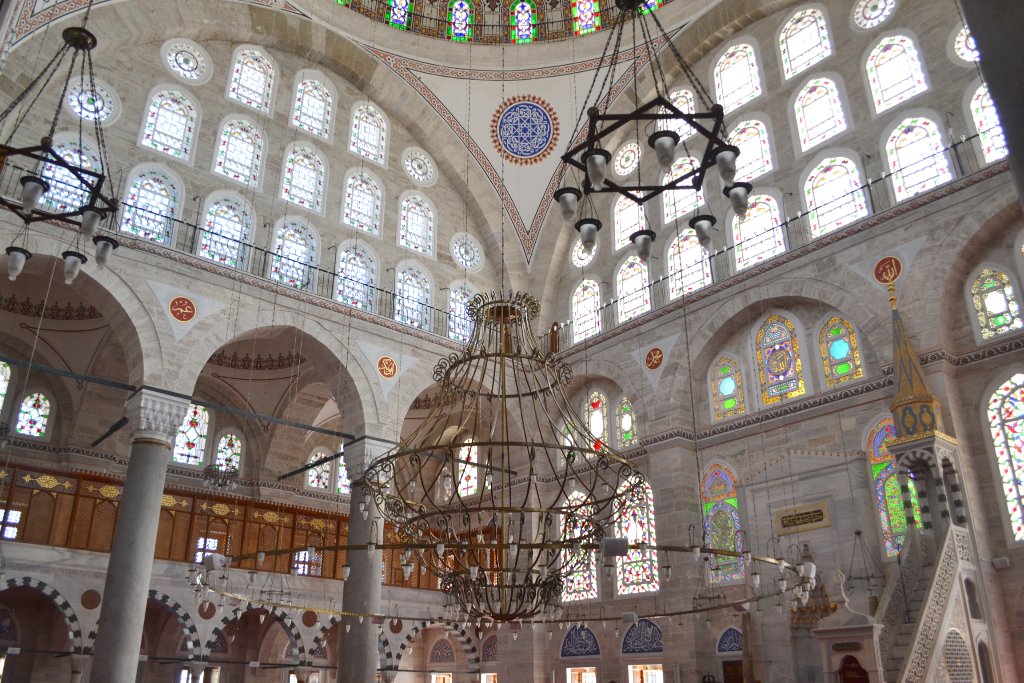
Mihrimah Sultan Mosque is another mosque built on the Western edge of Istanbul, just inside the Theodosian Walls. It’s probably Istanbul’s best example of a mosque built with a pendentive dome over four flat walls. This design is a little more limiting from a structural point of view when compared to other designs that utilize half domes, however, it allows for the most natural light to enter the space. As a result, the interior of the Mihrimah Sultan Mosque is extremely bright, and the multi-colored stained glass windows create an incredible effect not seen in other mosques across Istanbul.
9. Fountain of Ahmed III
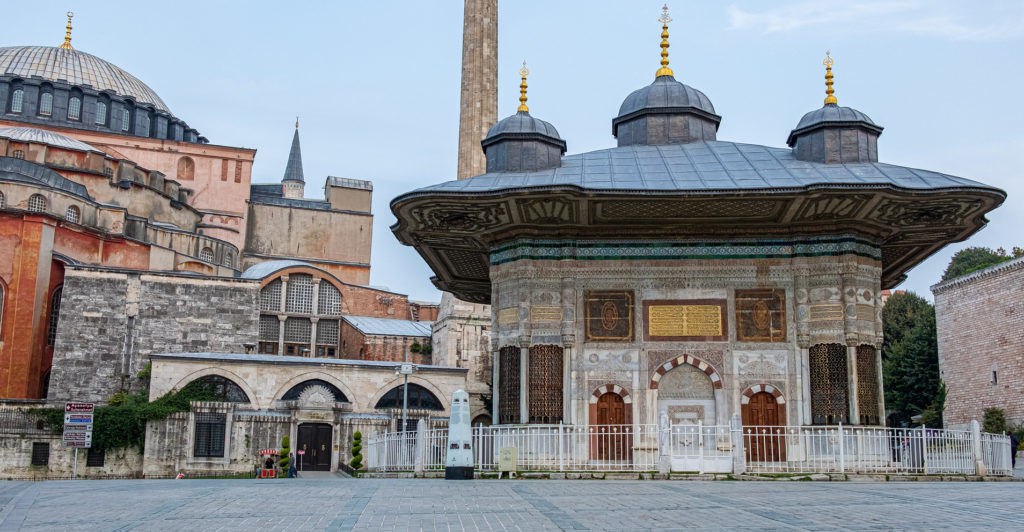
The Fountain of Ahmed III is located just outside the Hagia Sophia in Istanbul’s Fatih District. The Islamic world has a strong connection with water and fountains, and most mosques contain their own fountains and wells, which are often used in Islamic religious practices. The Ottomans utilized fountains throughout their cities as a way to provide fresh water to the public and help keep the peace. The Fountain of Ahmed III is often regarded as the greatest example of this found within Istanbul. It was constructed in 1728 and it contains a rectangular base with separate water taps on all four sides. Atop the base is a large roof structure that cantilevers several feet in all directions to protect people from the weather as they utilize the fountain.
10. Ortaköy Mosque
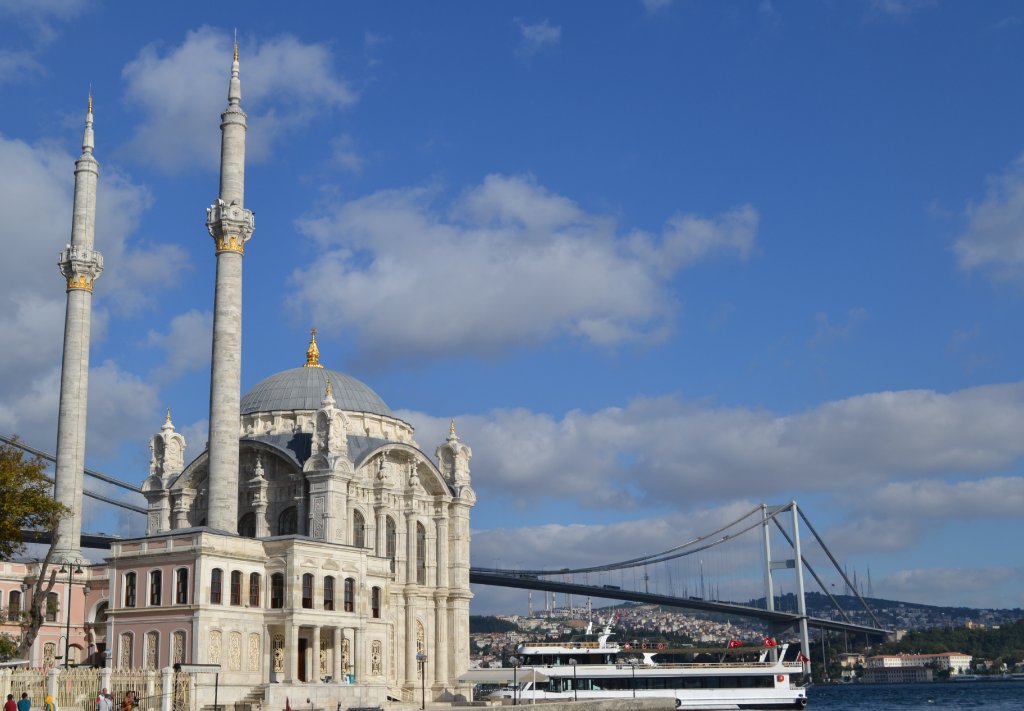
Ortaköy is a neighborhood in Istanbul that lies to the north of the city center, on the eastern shore of the Bosphorus. It’s a popular hangout spot for local Turks and the area is filled with many bars, hookah lounges, and restaurants. The Ortaköy Mosque is one of the most architecturally significant mosques in the entire city. It’s a rare example of an Islamic Building designed in the Baroque Style. Like many other works of Baroque Architecture, the Ortaköy mosque is lavishly detailed with intricate stone carvings, and it has a few accents that are coated with gold leaf.
11. Beyazıt Square & Bayezid II Mosque
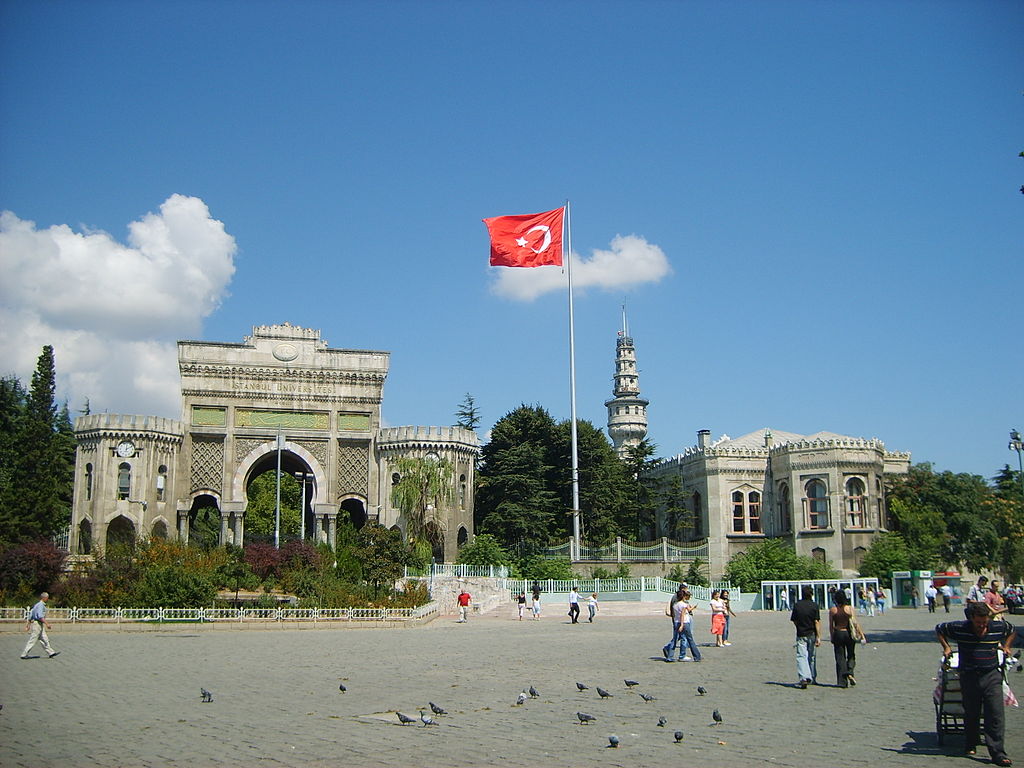
Beyazit Square and the adjacent Bayezid II Mosque, are both impressive works of Ottoman Architecture within central Istanbul. The square itself is situated right next to the campus of Istanbul University. The image above shows a large monumental gateway that serves as the main threshold onto the campus. The gateway is similar to the Triumphal Arches of the Ancient Romans, but here the design utilizes horseshoe arches, calligraphy, and other elements from Islamic Architecture. The Bayezid II Mosque is located on the eastern side of the Square. It was built in the early 1500s, making it one of the oldest examples of Ottoman Architecture in Istanbul.
12. Fatih Mosque

The Fatih Mosque is another large Ottoman Style Mosque located in the historic Fatih District of Istanbul. The building was constructed on the site of a much older work of Byzantine Architecture known as the Church of the Holy Apostles. The church was torn down after the Fall of Constantinople in 1453, and some of the important artifacts from the church were later moved to the Istanbul Archeological Museum. The Fatih Mosque was completed in 1771, and it greatly resembles many older Ottoman Mosques within Istanbul.
13. Şehzade Mosque
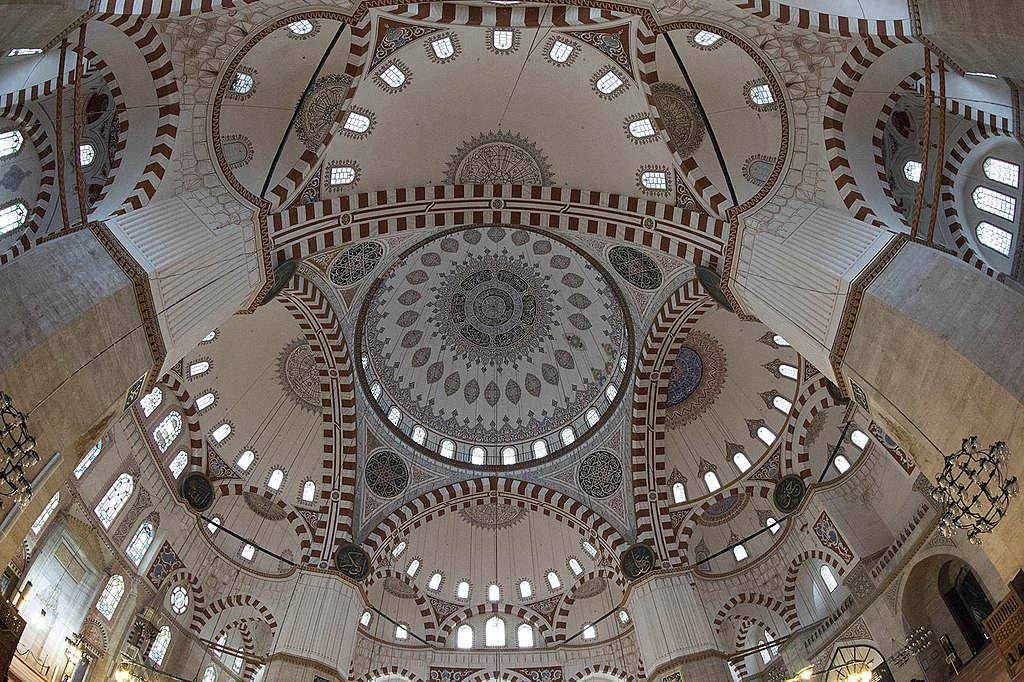
The Şehzade Mosque was completed in 1543, and it’s a typical work of Ottoman Architecture in Istanbul. Located not far from the Roman Aqueduct of Valens, the mosque was designed with a pendentive dome supported by four half domes. This creates a very large interior space that is symmetrical across all axes. In the image above, you can see what this type of interior space looks like. The prayer hall within Şehzade Mosque is open and airy, and it encloses a central location for worshippers to gather.
14. Çırağan Palace
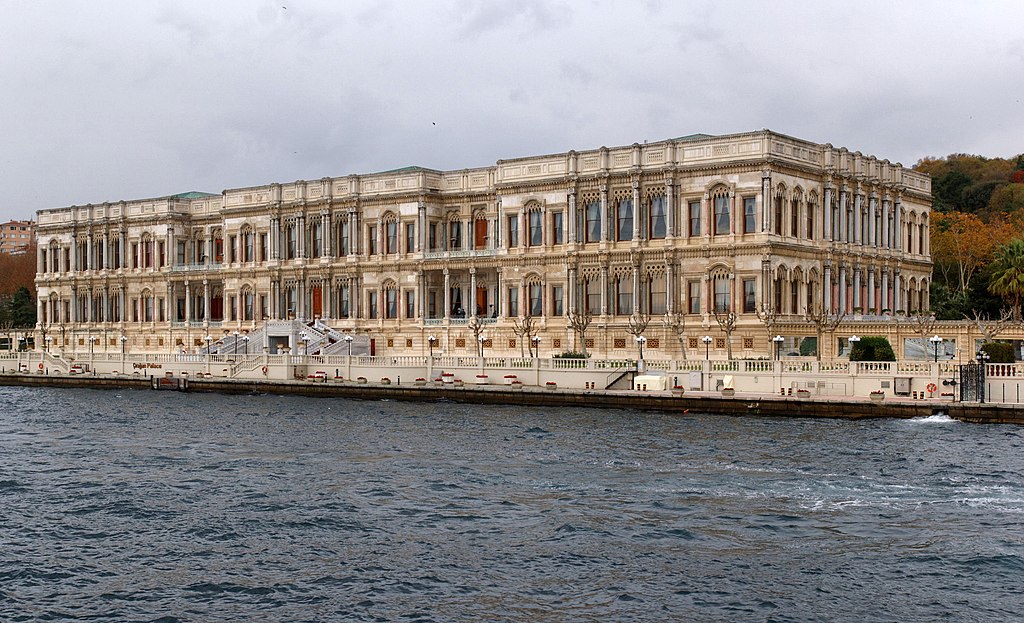
Çırağan Palace is one of the final palaces built during the later stages of the Ottoman Empire. It’s located on the Western shore of the Bosphorus Strait, in between the neighborhoods of Galata and Ortaköy. Construction took place from 1863–1867 and the sultans specifically designed the palace with all of the typical comforts of the late 1800s, including plumbing and electricity. Today, the interior of Çırağan Palace has been completely rebuilt after a fire in the early 20th century, and it now houses a 5-star luxury hotel.
15. Tophane Fountain
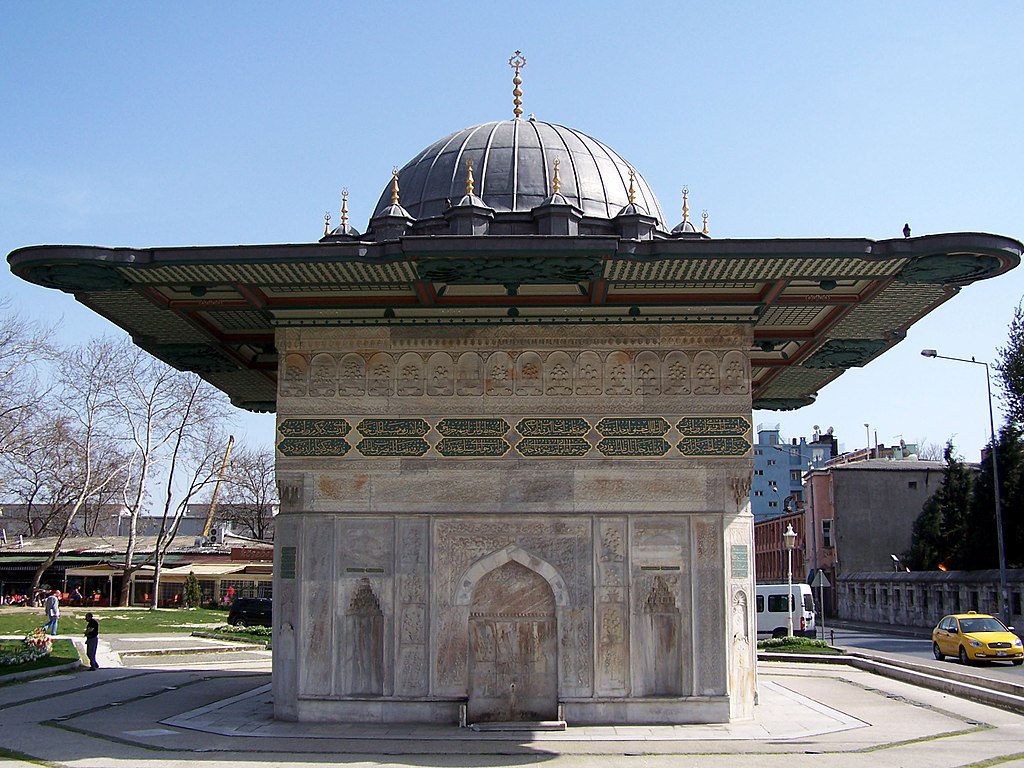
Like the Fountain of Ahmed III, Tophane Fountain is an Ottoman water source that is located north of the city center on the European side of the Bosphorus. The fountain is built in the exact same design as several others throughout the city. It has a lower boxy volume, topped with a deep overhead canopy. Tophane Fountain is made from intricately carved white marble, and there are several decorative niches on each side. The central niche contains the water taps and features a pointed arch, and the side niches are built with elaborate Muqarnas.
16. Tiled Kiosk
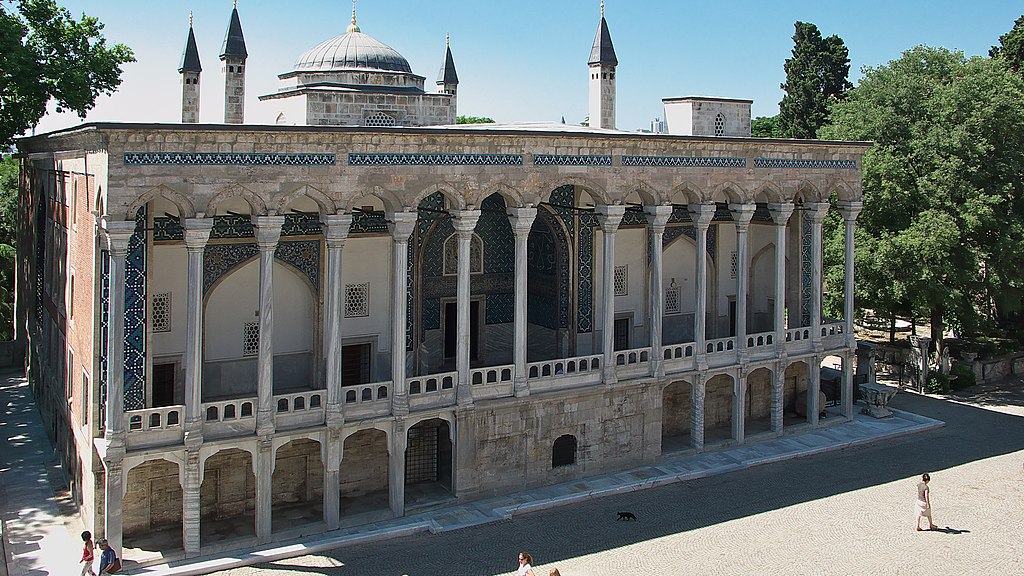
The Tiled Kiosk is a building located within the grounds of Topkapı Palace. It was built in 1472, in the years immediately following the Ottoman Conquest of the city. The small structure is richly decorated with tiles, decorated in the Turquoise Blue color found throughout the architecture of Istanbul. Today, anyone can visit the Tiled Kiosk, which is now part of the Istanbul Archeological Museum.
17. Rüstem Pasha Mosque
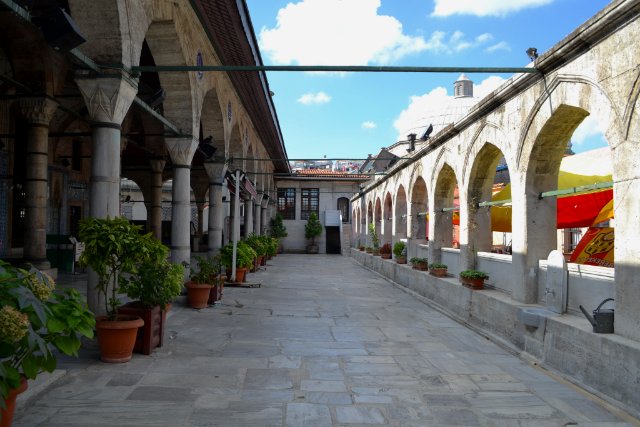
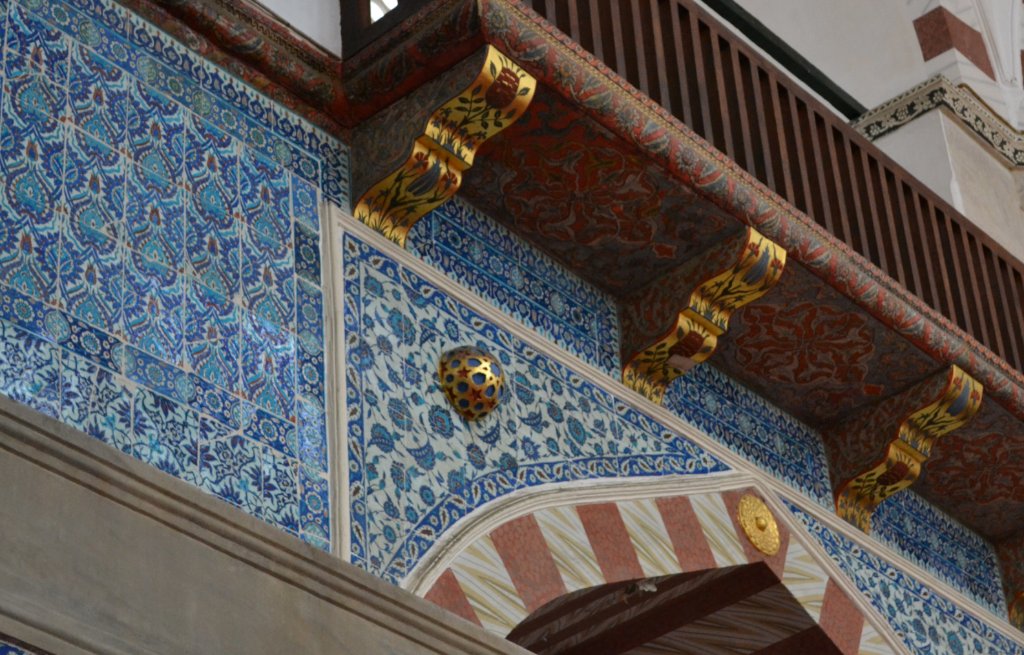
The Rüstem Pasha Mosque is a small Ottoman building located not far from the Galata Bridge and the waters of the Golden Horn. Like the Tiled Kiosk, the mosque is known for its abundance of light blue tiles. Many locals refer to the Rüstem Pasha Mosque simply as the “Tiled Mosque” because it contains such an incredible collection of these works of art. The tiles within the mosque all feature light-blue-and-white patterns of plants, flowers, and other geometric shapes. Many locals enjoy visiting the Rüstem Pasha Mosque because of its quiet and intimate interior, which contrasts the business of some of Istanbul’s larger mosques.
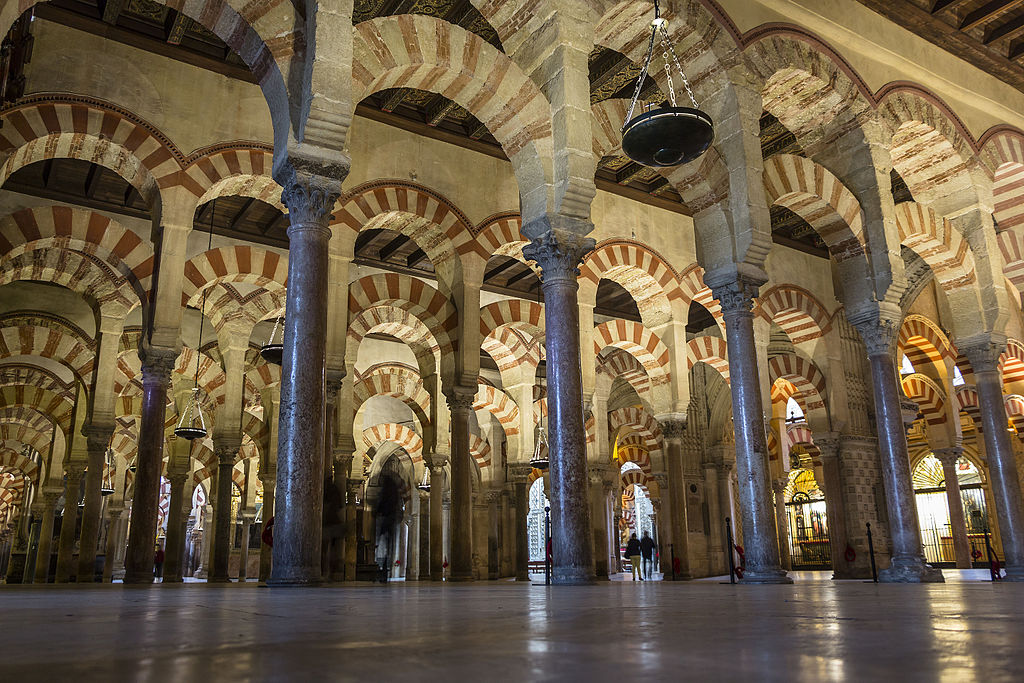
Interested in Islamic Architecture? Check out our article on the Moorish Architecture of Spain to learn more!
18. Beylerbeyi Palace
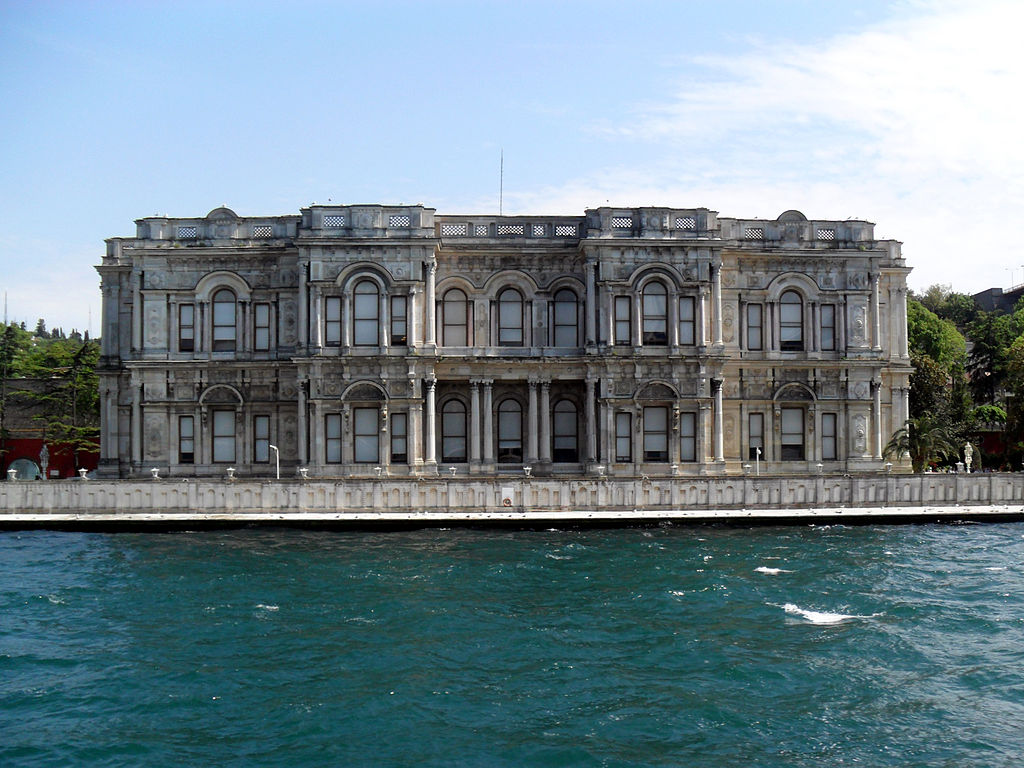
Beylerbeyi Palace is another late Ottoman Royal Residence located along the waters of the Bosphorus. It was completed in 1865 and served mostly as a summer residence for the sultans. The palace sits on the Asian side of the Bosphorus, adjacent to the Bosphorus Bridge. During the 1800s, it was common for the Ottoman Sultans to host guests from both Europe and the Middle East, and many royals and diplomats stayed within Beylerbeyi Palace while they visited Istanbul.
19. Istanbul Archaeological Museum

The Istanbul Archeological Museum is one of the city’s most impressive museums. It opened in 1891, and it contains a plethora of historic artifacts dating to every age of the city. There are ancient artifacts from the days of the Roman Empire and the ancient Greeks, in addition to Byzantine Artifacts and treasures from the early days of the Ottoman Empire. The museum was constructed within the inner walls of the city, right next to Topkapı Palace. Istanbul Archeological Museum was designed in the Neoclassical Style, which was the world’s dominant architectural style during much of the 19th century.
20. Nuruosmaniye Mosque
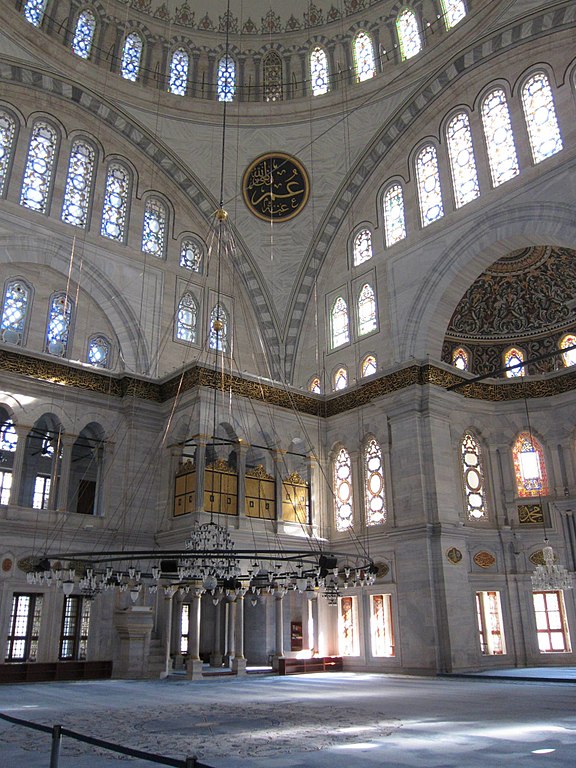
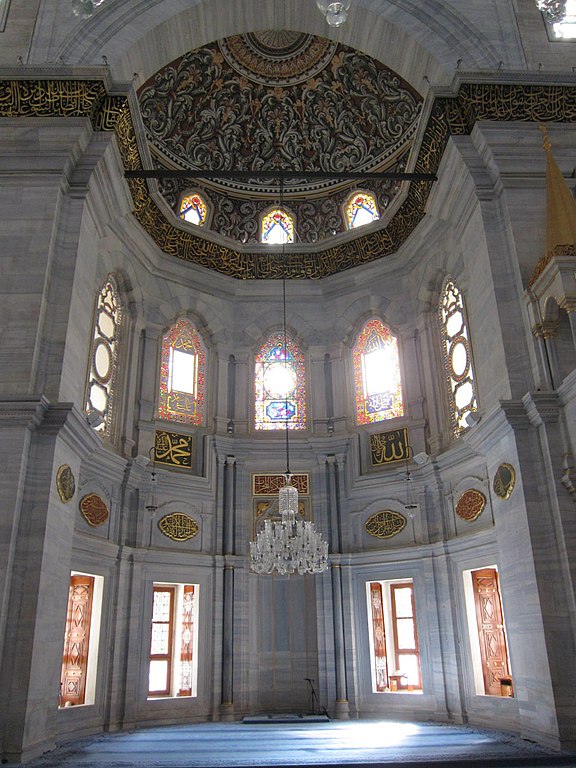
Nuruosnaniye Mosque is another great example of Ottoman architecture found in Istanbul. It was completed in 1755 and is designed with a large pendentive dome over four flat walls. The interior is relatively colorless, and the white and light gray stonework creates a neutral and calming space. Nuruosnaniye Mosque is situated in the heart of Istanbul’s Fatih district, right next to the Triumphal Column of Constantine and the old Roman Forum. This building helps to illustrate the variety in all of Istanbul’s Mosques. Although most are designed in a similar shape, each one contains its own personality with a different look and feel depending on the finishes and materials that were selected.
21. Ihlamur Pavilion
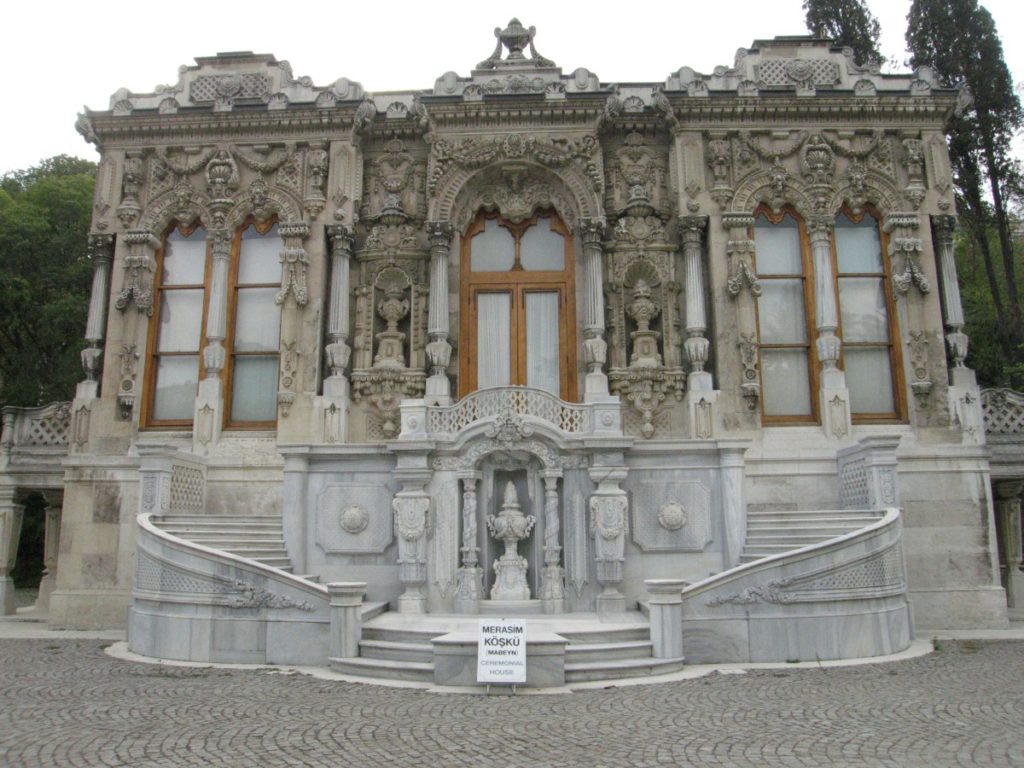
The Ihlamur Pavilion is a small late-Ottoman building located on the European side of Istanbul. It was completed in the mid-19th century, long after the Baroque and Rococo Ages faded away in the rest of Europe. In spite of this, the Ihlamur Pavillion was heavily influenced by these two styles. Many of the key elements found in Rococo Architecture can be seen in the pavilion’s exterior. This makes the Ihlamur Pavilion one of only a few examples of Rococo & Late Baroque Architecture in Istanbul, in addition to Ortaköy Mosque and Dolmabahçe Palace.
22. Kılıç Ali Pasha Complex
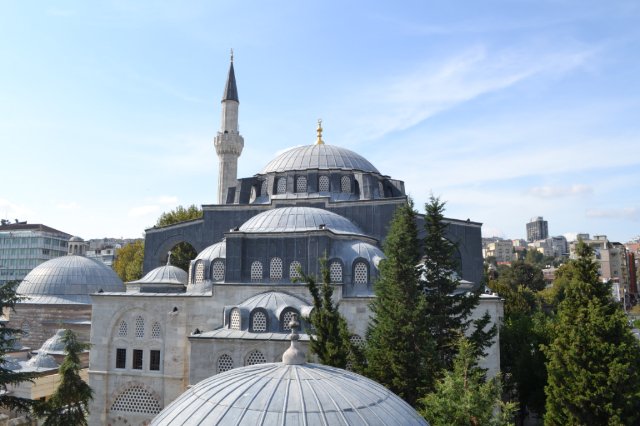
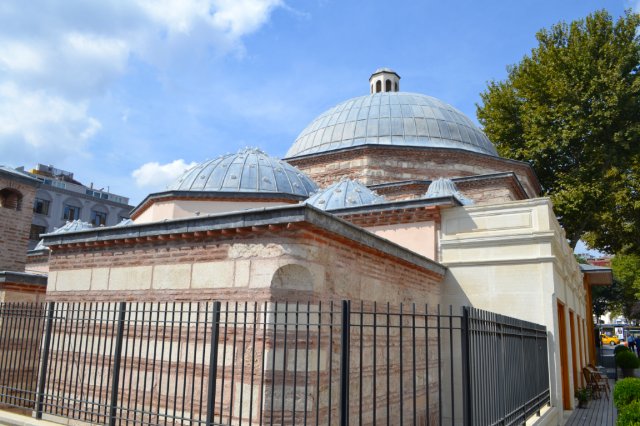
The Mosque of Kilic Ali Pasha was completed in 1580 and was designed by the great Ottoman architect Mimar Sinan. Mimar Sinan was one of the most active architects in world history, and many of his buildings can be found throughout Istanbul and the former lands of the Ottoman Empire. The Mosque of Kilic Ali Pasha was designed at the tail end of Sinan’s career. The right image above shows a small Hammam or Bath House, which is also part of the overall Kilik Ali Pasha Complex.
23. Rumelihisarı

The Rumelihisarı, which roughly translates to “Strait-Cutter Castle”, is a work of Ottoman Military Architecture located a few miles up the Bosphorus from Istanbul. It was commissioned by Memed II in 1452, shortly before he would conquer Constantinople. The castle was designed to do exactly what its name implies: to cut off Constantinople from the upper portion of the Bosphorus Strait. Its construction allowed the Ottomans to control all of the ships that passed down the waters of the Bosphorus, which connects the Black Sea and the Mediterranean Sea. The Rumelihisarı is one of the Strongest Castles ever built, and its completion was integral to the Ottoman Conquest of Constantinople.
24. Hurrem Sultan Bathhouse
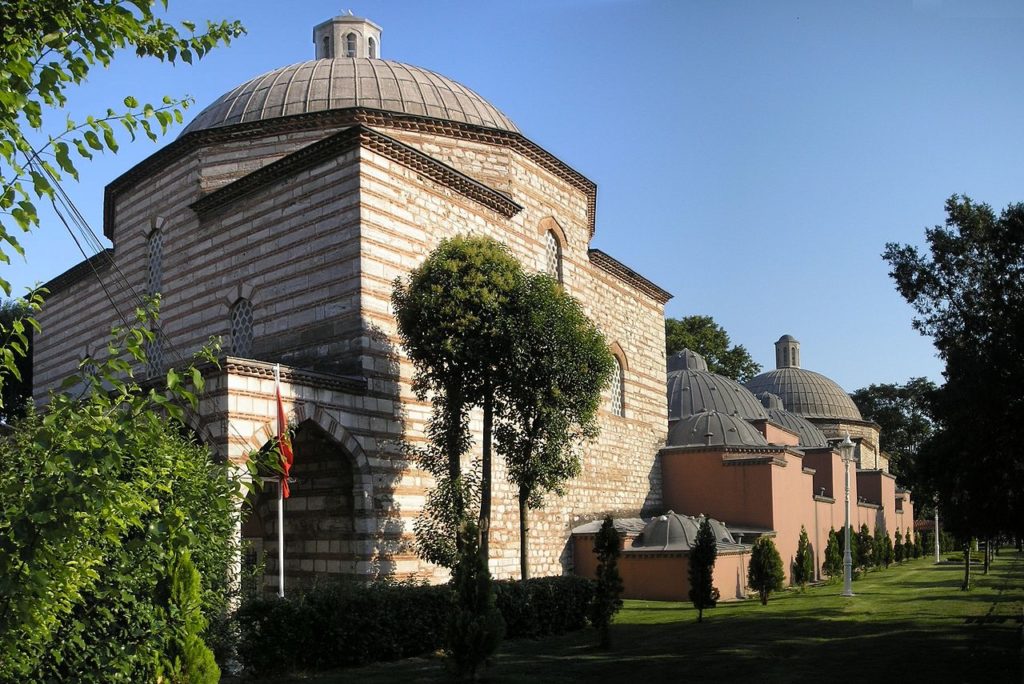
The Hurrem Sultan Bathhouse is a Hammam located within the historic center of Istanbul. It’s prominently positioned right next to the Hagia Sophia and Sultanahmet Square. The building was designed by the Ottoman architect Mimar Sinan, and it’s one of only a few Turkish Baths designed by him. It was completed during the reign of Suleiman the Magnificent, and it represents the power and splendor of the Ottoman Golden Age. The bathhouse is comprised of a series of chambers, each topped with its own dome. These chambers served different functions, for bathing in hot vs. cold water and for actual washing vs. just relaxing.
25. German Fountain

While not necessarily a work of Ottoman Architecture, the German Fountain is a monument dating from the tail end of the Ottoman Empire. Up until the outbreak of WWI in 1914, the Ottomans were closely allied with the newly unified state of Germany. Both sides fought together against the Allies in WWI, and they shared a common enemy in the Russian Empire. The German Fountain was donated to the city of Istanbul by the German Kaiser Wilhelm II and it was installed within Sultanahmet Square in 1900.
Like Architecture of Cities? Sign up for our mailing list to get updates on our latest articles and other information related to Architectural History.
Modern Architecture in Istanbul
After its defeat in WWI, the Ottoman Empire collapsed, and Istanbul was occupied by the British Army. Then, after the Turkish War of Independence, the modern-day nation of Turkey was born. Turkey emerged under the leadership of its first president, Mustafa Kemal Atatürk. Today, he is known as the founder of Turkey and is regarded as a national hero. He was also the first person to formally change the name of the city from Constantinople to Istanbul. Although Ankara is Turkey’s capital, Istanbul remains the nation’s largest and most important city. Istanbul is home to countless examples of modern architecture, and some of its most important buildings and pieces of infrastructure were built after the formation of the Republic of Turkey.
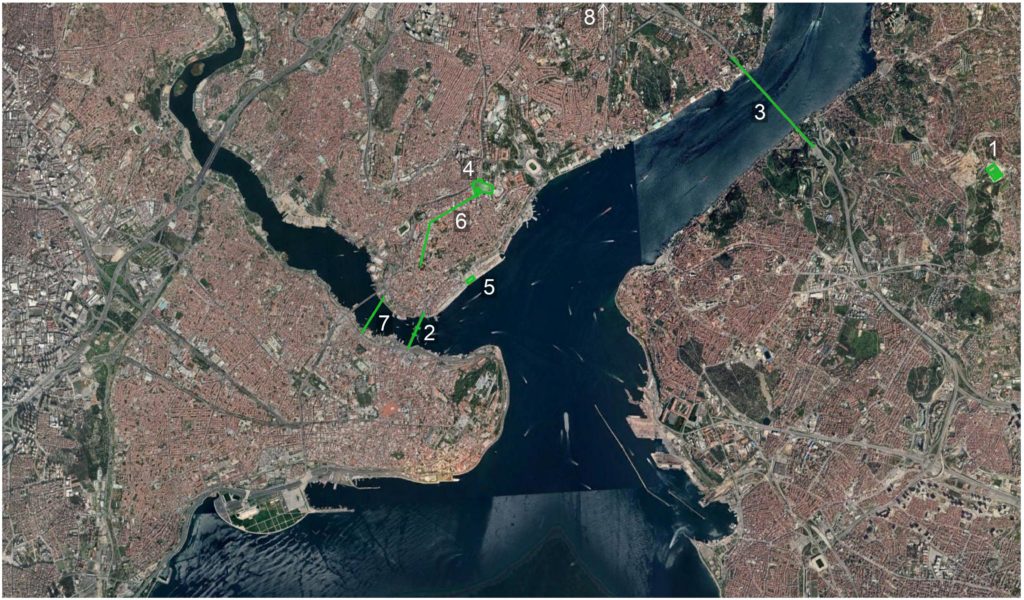
Map of Istanbul highlighting the most notable works of Modern Architecture within the city.
Note: #8 on this list is not depicted.
1. Çamlıca Mosque

Located on the Asian side of Istanbul, the Çamlıca Mosque is a modern work of architecture that was completed in 2019. It was built in the Ottoman style, in a similar form to several other mosques in Istanbul, such as the Blue Mosque and Süleymaniye. Although the project was controversial, as many locals believed the project funding could have been better spent in other ways, the mosque represents Turkey’s long-lasting tradition of constructing some of the world’s greatest religious monuments. The Çamlıca Mosque was largely completed thanks to the efforts of Recep Tayyip Erdoğan, a former prime minister of Turkey who has been serving as president since 2014.
2. Galata Bridge
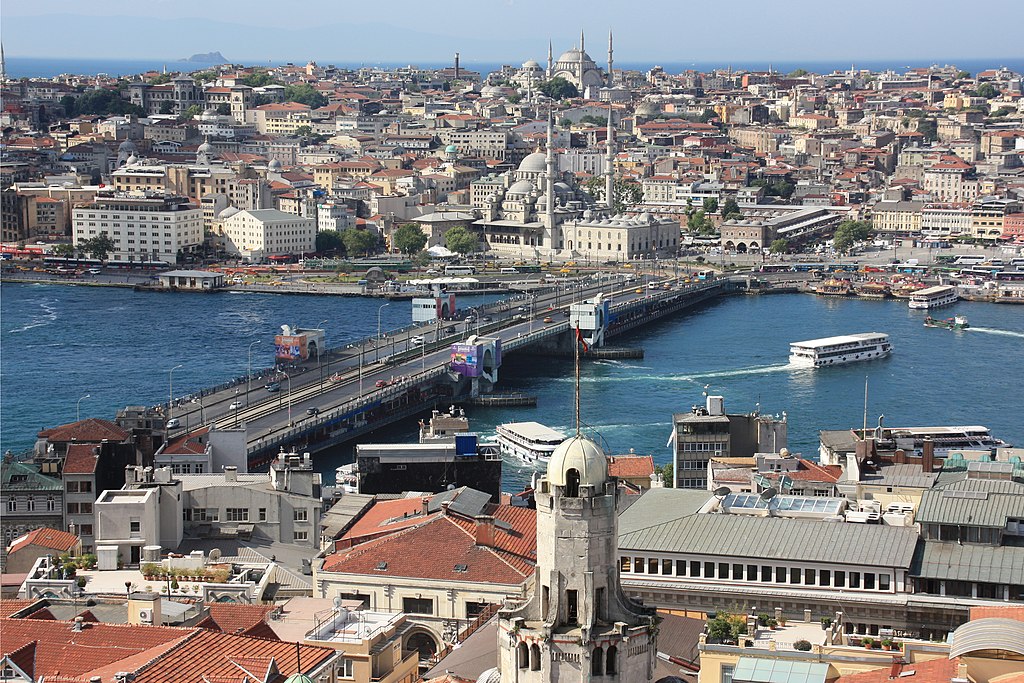
The Galata Bridge spans the Golden Horn and connects the historic core of Istanbul with the Galata Neighborhood. It was completed in 1994, and it’s the latest in a series of bridges that have crossed the same area since the 19th century. The bridge itself is a multi-level design with a road and sidewalks above and bars and restaurants below. The Galata Bridge is a popular spot for nightlife, and at virtually all times of the day, both decks of the bridge are busy, bustling, and lively. Each day, thousands of cars and pedestrians cross the bridge, making it one of the most vital arteries in and out of the city center.
3. Bosphorus Bridge
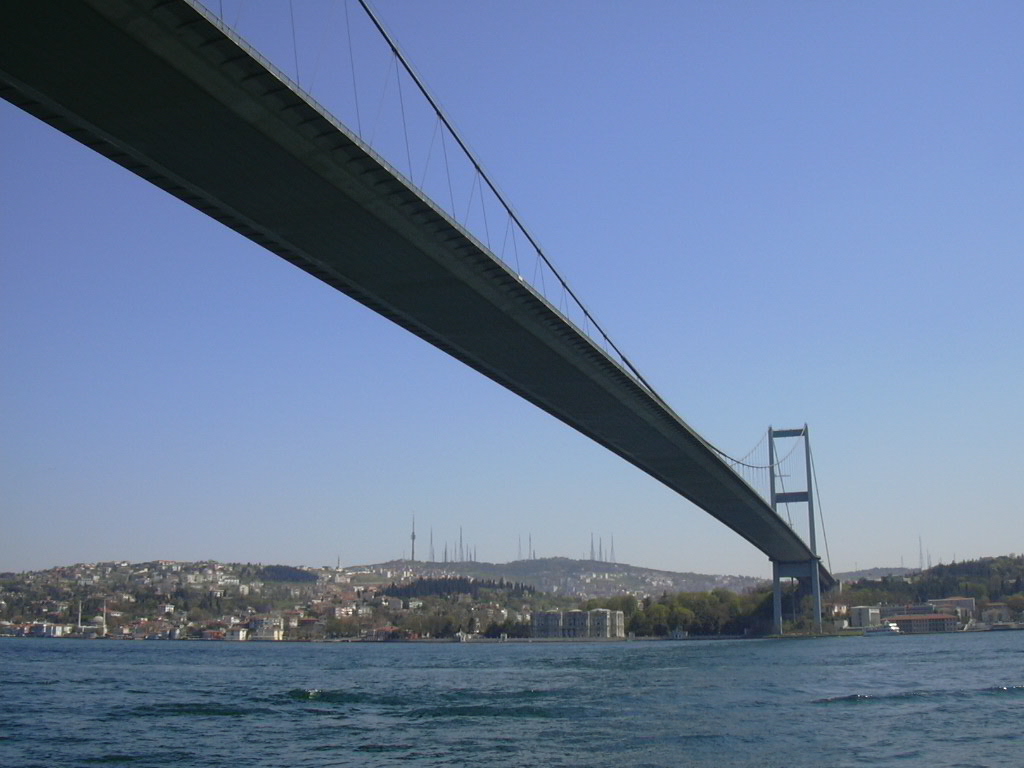
The Bosphorus Bridge is a vital piece of infrastructure within modern-day Turkey. When it was completed in 1973, it was the only connection point across the Bosphorus Strait between the European and Asian sides of Istanbul. It was a bold work of engineering, and at the time of its completion, it was one of the world’s longest suspension bridges. The Bridge spans over 5,000 feet (1500 m) and it’s situated overlooking Istanbul’s Ortaköy Neighborhood. Although two newer bridges were constructed later on, the Bosphorus Bridge is still the closest and most convenient crossing point from Istanbul’s city center.
4. Taksim Square & Republic Monument

Taksim Square is one of Istanbul’s busiest and most popular public spaces. It’s located at the termination point of İstiklal Avenue, a major pedestrian thoroughfare within the northern portion of central Istanbul. The square is typically full of people and crowds late into the evening thanks to its many restaurants, retailers, and commercial spaces. Taksim Square is also one of Istanbul’s most popular gathering points, and over the centuries, it has been used for public protests and special events. Within the center of the square, there is a large monument dedicated to Mustafa Kemal Atatürk. It commemorates his efforts in creating the modern-day Republic of Turkey and his achievements during the Turkish War of Independence.
5. Istanbul Modern

Istanbul Modern is a museum located along the shores of the Bosphorus within a former warehouse building. It opened in 2004 after an extensive renovation project, which completely revitalized the existing rundown structure. Since its opening, the museum has been welcoming visitors to a large collection of modern art, with rotating galleries curated by some of the world’s leading artists. The entire area around Istanbul Modern was very industrial up until the mid-20th century, and today city planners are working to improve the area and turn it into an up-and-coming destination for art and culture.
6. İstiklal Avenue
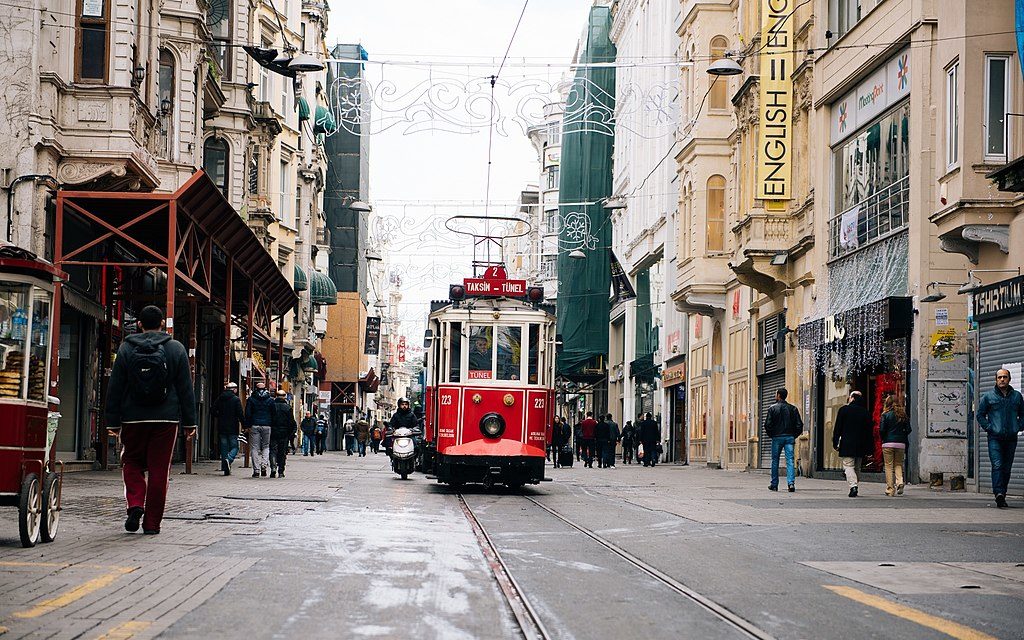
İstiklal Avenue is a major pedestrian thoroughfare connecting Istanbul’s Galata Neighborhood with Taksim Square. It takes about 20-30 minutes to leisurely walk up the street, and many regard it as one of the most pleasant and lively walks in all of Istanbul. İstiklal Avenue is lined with impressive works of architecture from the late 19th and early 20th centuries, and many of the ground floor spaces are filled with bars, restaurants, and retailers. There is also a famous nostalgic tramway that brings passengers up and down the street. The tram has been carrying passengers since it opened in 1990, It was built along the path of an older tramway with origins dating back to the 1870s.
7. Golden Horn Metro Bridge

One of the greatest works of Modern Architecture in Istanbul is the Golden Horn Metro bridge. It connects the historic center of Istanbul with the opposite side of the Golden Horn. The bridge has pathways for pedestrians, in addition to a railway line carrying the M2 Metro tram. The bridge opened in 2014, and it is the fourth and latest crossing point over the Golden Horn. Its design is an elegant form of a Cable-stayed Bridge, which has two large towers supporting the main roadway.
8. Levent Business District
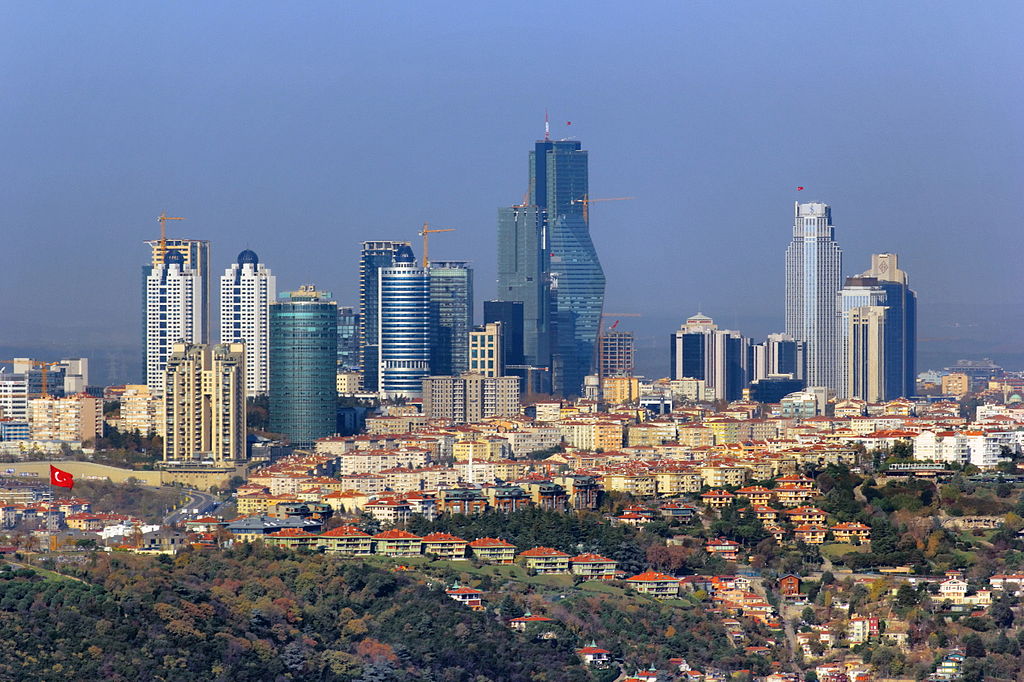
The Levent Business District is an area within greater Istanbul that is filled with modern, contemporary buildings. These structures mostly house offices, and many of Turkey’s largest corporations are headquartered here. The Levent Business District is located over 6 miles (10 km) away from the historic center of Istanbul, on the European side of the city. One of the most iconic buildings in the entire district is the Istanbul Sapphire, a blue-glass skyscraper that contains a popular shopping mall and a rooftop viewing platform. The Levent Business District is continually expanding, and its become an important spot for modern architecture within the vast urban area of Istanbul.

Interested in Revival Architecture? Check out our article on the Architecture of Stockholm to see more great examples of Revival Style Buildings.
Neighborhoods of Istanbul
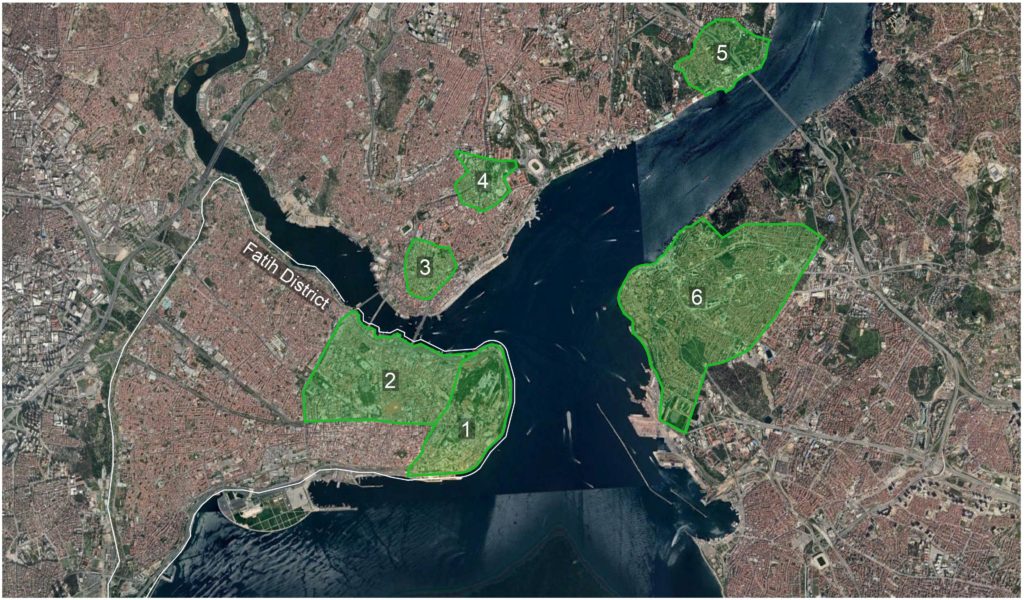
Map of Istanbul Showing the extents of various neighborhoods within the city
.

1. Sultanahmet
Sultanahmet is located on the eastern end of Istanbul’s main peninsula. It’s the neighborhood with the highest concentration of major sites, including the Hagia Sophia, the Blue Mosque, and the Hippodrome. It’s also one of the liveliest districts in the entire city, and it’s known to have large tourist crowds.
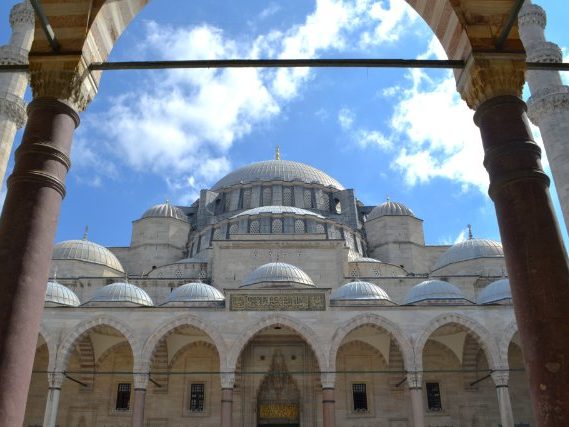
2. Eminönü
Eminönü is an important neighborhood within the oldest part of Istanbul: the Fatih District. It’s located just to the west of the Sultanahmet neighborhood, and it includes many prominent works of architecture, including Süleymaniye, the New Mosque, and the Grand Bazaar.

3. Galata
Galata is a neighborhood in Istanbul that originated as a Genoese trading colony. The colony was established in the 13th century, and it was strategically positioned just across the Golden Horn from the main city. Galata is of course known for the Galata Tower, but it’s also a hub for retail and commercial activity. The start of Istanbul’s famed Istiklal Avenue is also located within the Galata Neighborhood.
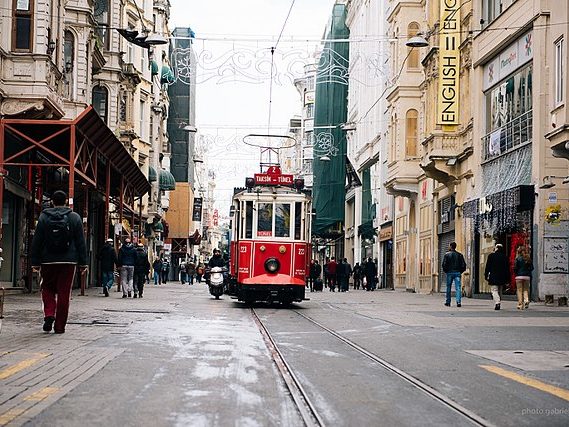
4. Taksim
The area around Taksim Square is known as the Taksim Neighborhood. This area is much more modern than many other parts of Istanbul, and it contains lots of newer buildings from the 20th century. The main site here is Taksim square and the adjacent Taksim Gezi Park, which is a large green space filled with lots of vegetation and a central decorative fountain.
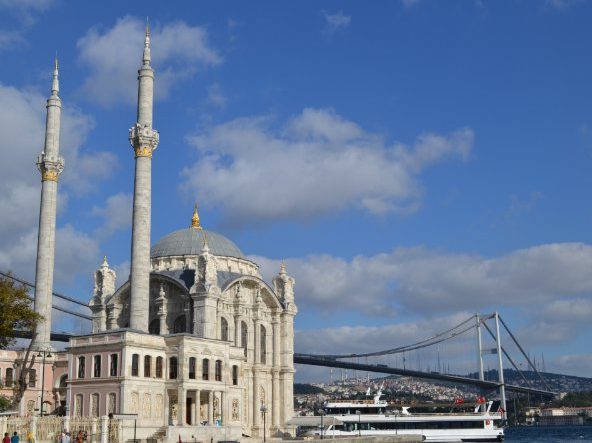
5. Ortaköy
Ortaköy is a lively and vibrant neighborhood, located 3 miles (5 km) up the Bosphorus from Istanbul’s Historic Center. The neighborhood is a popular hangout spot for locals, and it’s filled with many hookah lounges, clubs, and restaurants. A few of the neighborhood’s more noteworthy sights include Ortaköy Square, Ortaköy Mosque, and the Bosphorus Bridge.
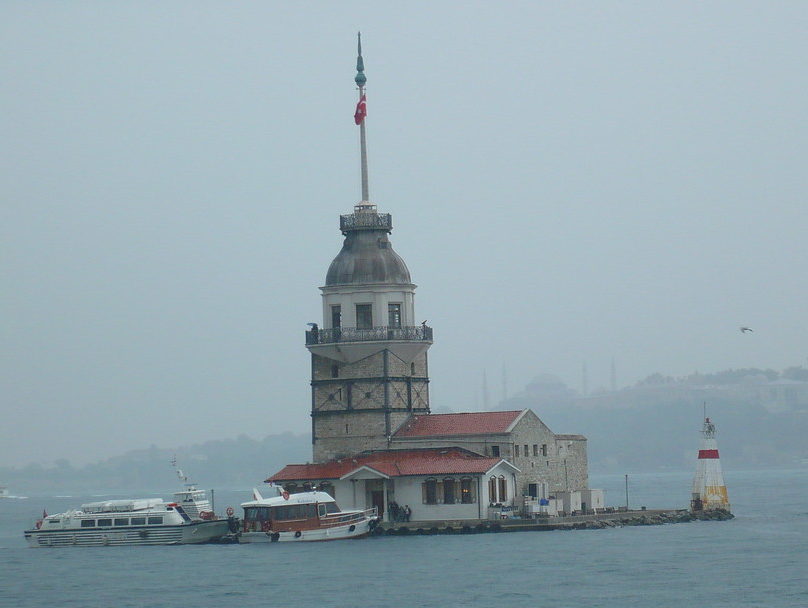
6. Kadıköy District
The Asian side of Istanbul is often overlooked by tourists, but many of the city’s most vibrant neighborhoods are located here on the Eastern side of the Bosphorus. The entire area is known as the Kadıköy District and it contains neighborhoods such as Harem, Üsküdar, and Ümraniye. The Çamlıca Mosque is probably the most notable site on this side of the city, in addition to the Maidens Tower, which is located on an island just offshore.
Architecture of Istanbul: In Review
Istanbul truly is one of the world’s greatest cities. It has a long and storied history, and many groups, including the Byzantine Empire, the Ottoman Empire, and the modern Republic of Turkey, have all left their mark on the architecture of Istanbul. In addition to wonders like Süleymaniye and the Hagia Sophia, Istanbul is home to dozens of lesser-known but still significant buildings. Any fan of architecture is sure to enjoy Istanbul, and today the city remains a crossroads of Eastern and Western cultures, as it has been for thousands of years.

- About the Author
- Rob Carney, the founder and lead writer for Architecture of Cities has been studying the history of architecture for over 15 years.
- He is an avid traveler and photographer, and he is passionate about buildings and building history.
- Rob has a B.S. and a Master’s degree in Architecture and has worked as an architect and engineer in the Boston area for 10 years.
Like Architecture of Cities? Sign up for our mailing list to get updates on our latest articles and other information related to Architectural History.



